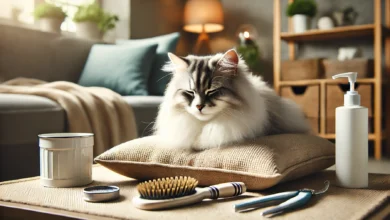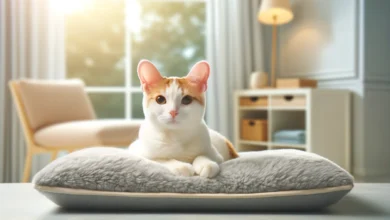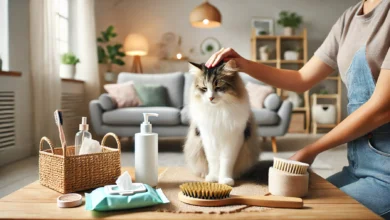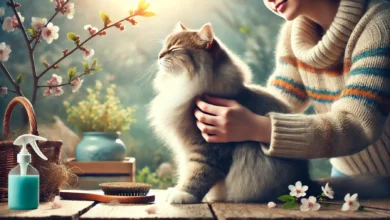Managing Cat Shedding with Proper Tools and Tips
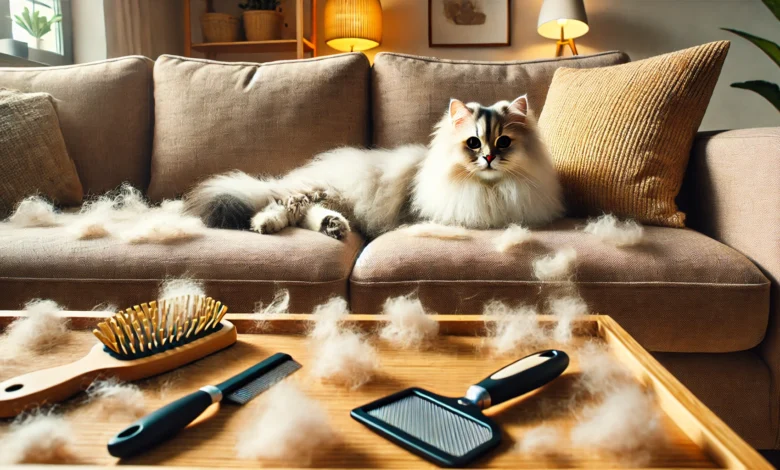
Cats are admired for their beautiful coats, but to many cat owners, the incessant hair shedding is often a problem and can be a big headache.
Shedding is a natural process for cats, but fur everywhere in the house can cause allergies, furniture covered in hair, and require additional cleaning efforts.
Fortunately, with the proper tools and good grooming habits, you can control the amount of cat shedding while keeping your cat’s coat healthy and shiny.
This article will discuss the causes of cat shedding and provide useful tips on how to manage it effectively.
Table of Contents
Understanding Why Cats Shed
Before delving into how to control cat shedding, it’s important to understand why cats shed in the first place.
Shedding is a natural process for cats.
They shed to remove dead fur and make room for new, healthy fur.
This process helps regulate their body temperature and keeps their skin healthy.
Without shedding, a cat’s coat wouldn’t be able to adapt to seasonal changes and temperature fluctuations.
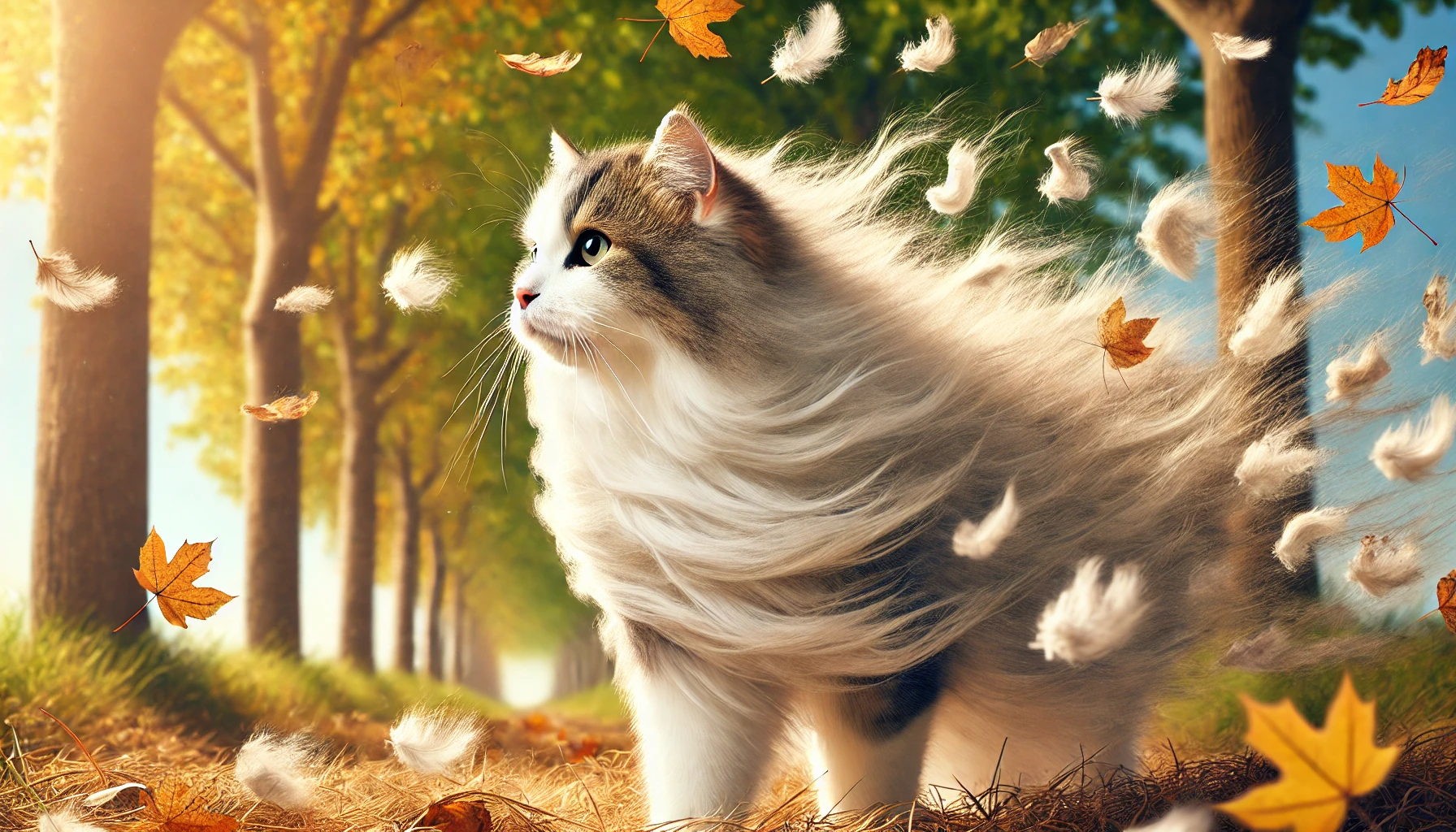
The Natural Shedding Cycle
Cats are intermittent shedders by nature.
Some cats shed more than others, but most experience heavier shedding during seasonal changes, particularly in spring and fall.
Their coats adjust to warmer or cooler temperatures by shedding excess fur.
Outdoor cats tend to follow a strict seasonal shedding pattern, while indoor cats may shed consistently throughout the year due to constant indoor conditions.
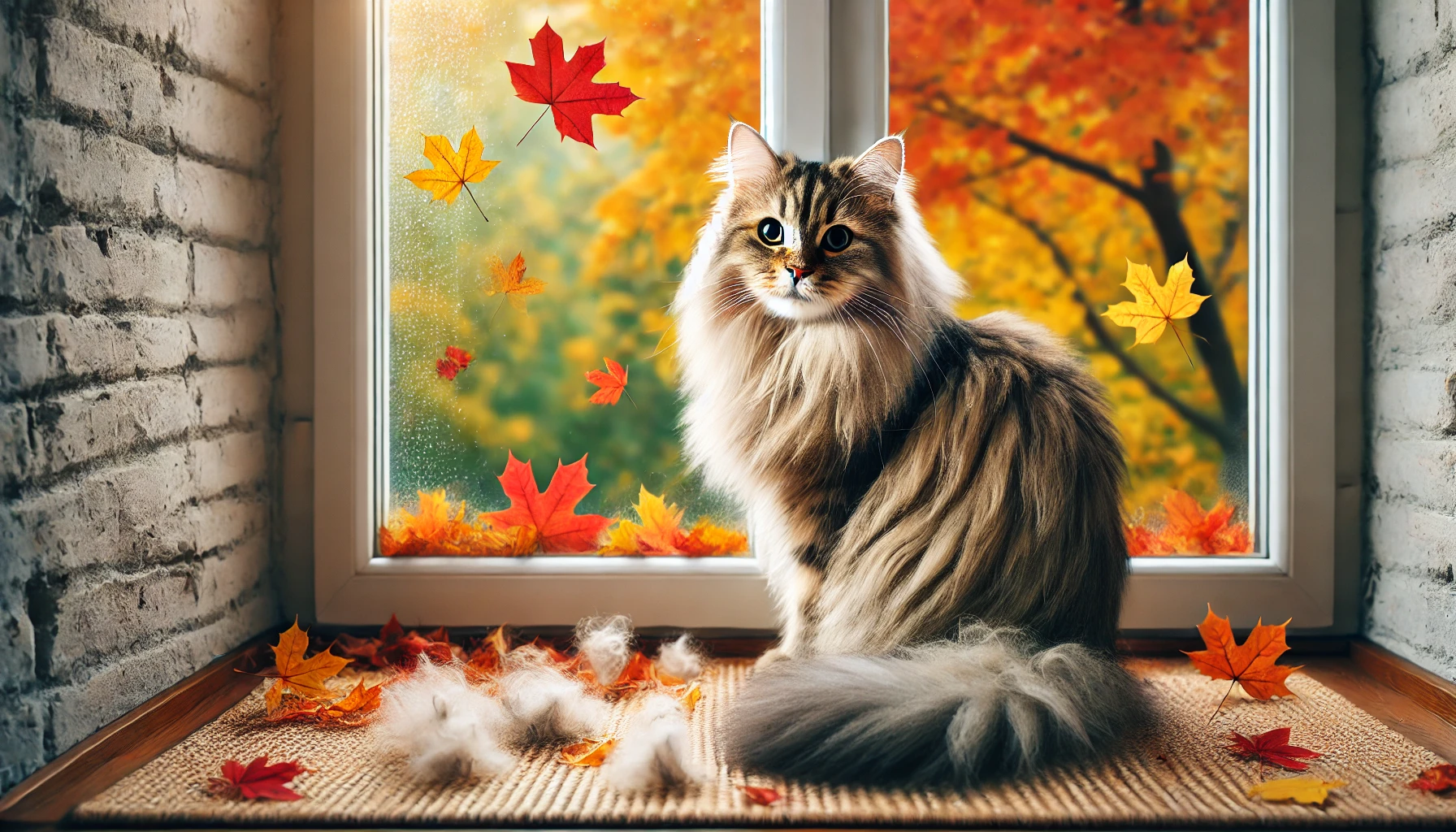
Shedding Season in Cats
If you notice that your cat sheds significantly more at certain times of the year, you’re not alone.
Seasonal shedding is common, especially in long-haired breeds.
In spring, cats shed their thick winter coats to prepare for warmer weather, and in fall, they shed their lighter summer coats to grow thicker fur for winter.
This allows them to easily adapt to changing temperatures.
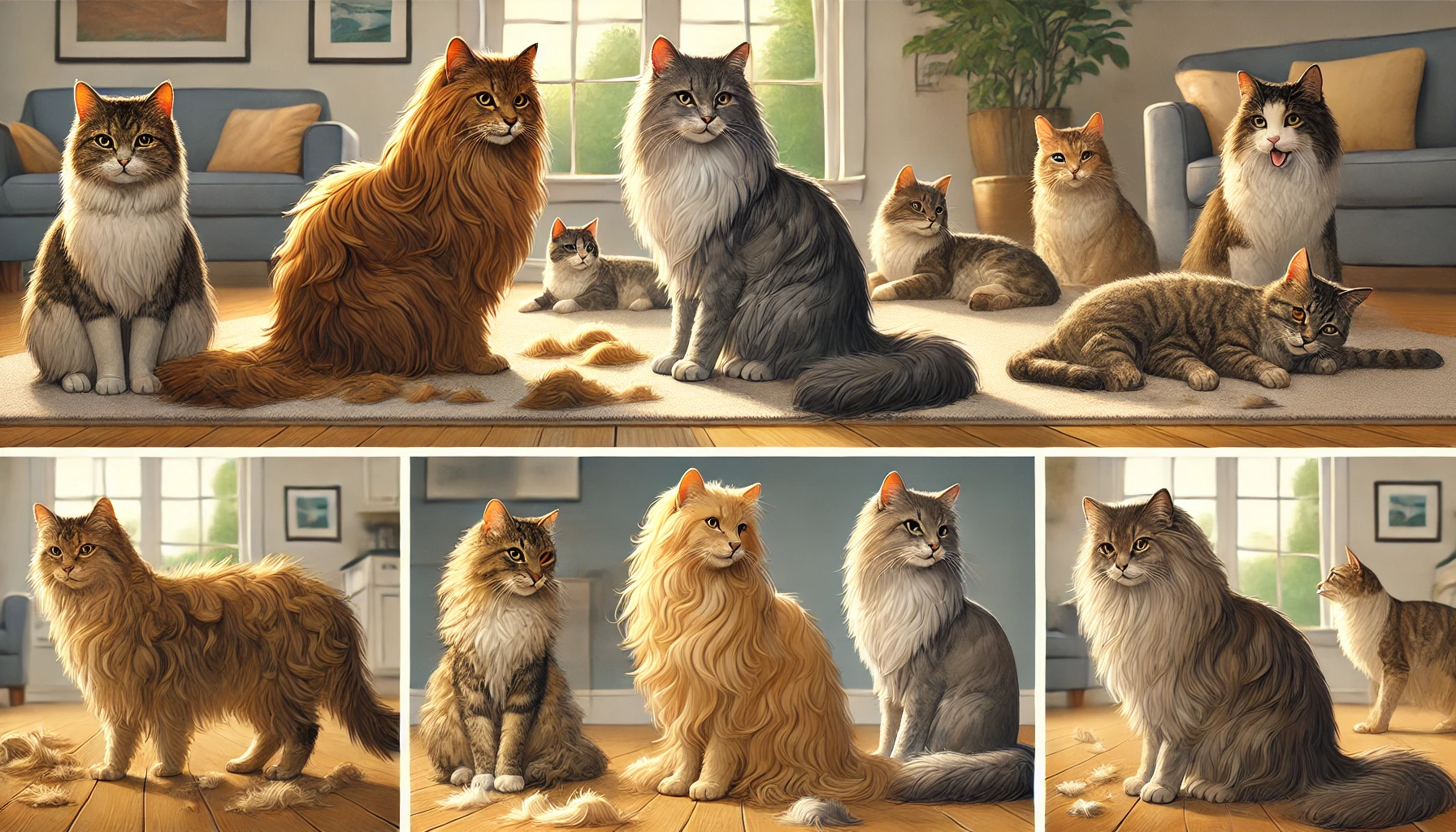
Shedding Factors
Several factors influence how much a cat sheds, including their breed, age, diet, and overall health.
Long-haired cats, such as Persians and Maine Coons, are more prone to shedding compared to short-haired breeds.
Cats that aren’t groomed regularly or are fed poor diets may shed excessively.
Stress, allergies, and certain medical conditions can also contribute to increased shedding.
If you notice sudden changes in your cat’s shedding patterns, it’s important to investigate the underlying causes.
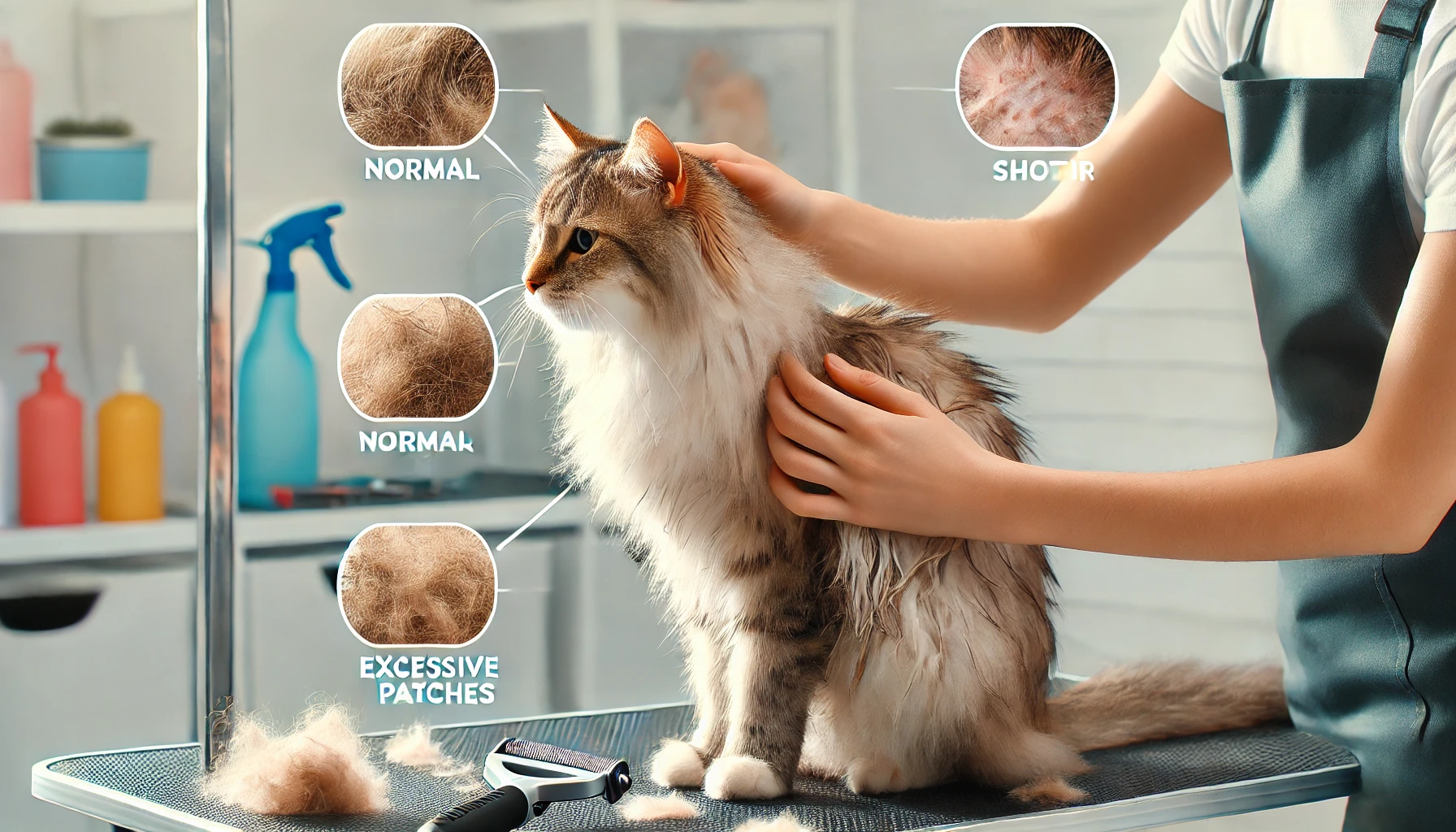
Distinguishing Between Normal and Excessive Shedding
It’s essential to differentiate between normal and excessive shedding.
Normal shedding is a gradual process where your cat loses fur over time.
However, excessive shedding can be a sign of an underlying health issue.
If you notice bald patches, flaky skin, or extreme fur loss, it could indicate a problem that requires a veterinarian’s attention.
Cats shed to remove dead fur, regulate body temperature, and keep their skin healthy. This process is essential for their well-being, especially during seasonal changes when their coat adjusts to different temperatures.
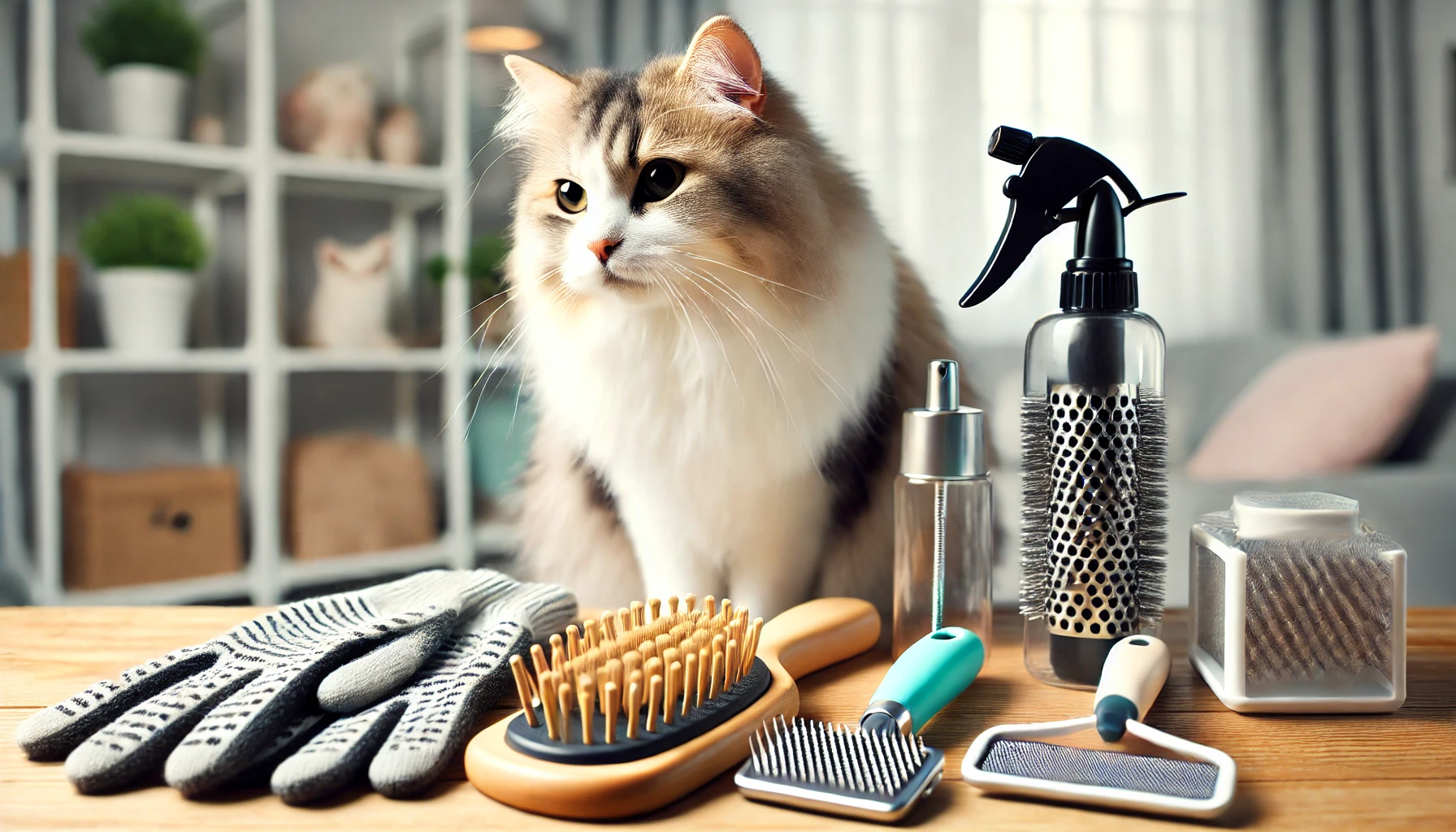
Essential Tools to Handle Cat Shedding
Managing cat shedding requires more than just brushing your cat from time to time.
To handle cat shedding effectively, you need the right tools, customized for the type of fur your cat has.
The right grooming tools help reduce the amount of loose fur and contribute to maintaining your cat’s overall coat health.
Regular grooming can also serve as a bonding moment where you can inspect your cat for any abnormalities in their fur or skin.
Below, we go over the most vital tools necessary when dealing with cat shedding.
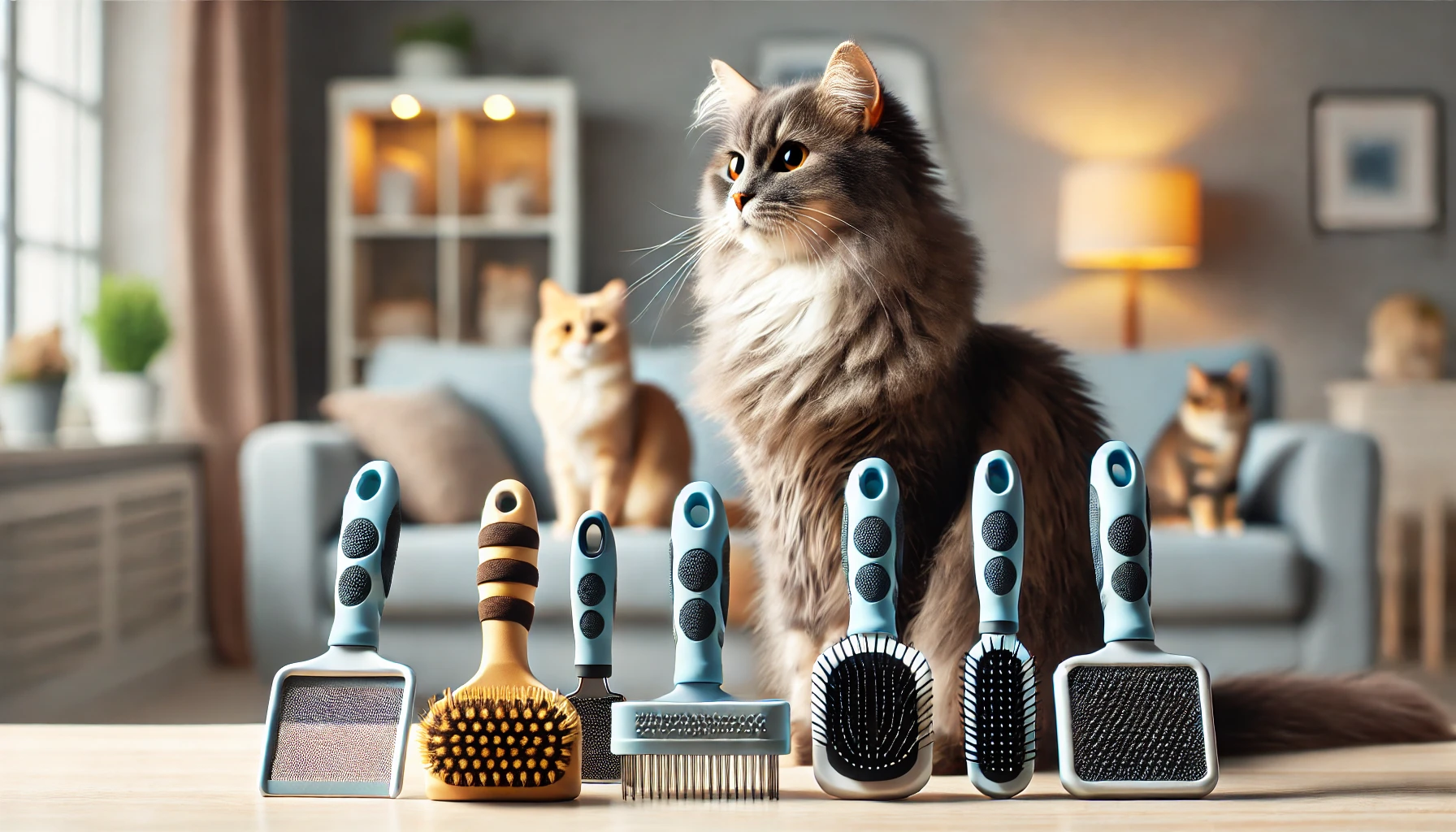
Which Brush to Get for What Fur
Not all cats have the same type of fur, and choosing the right brush makes a significant difference in managing cat shedding.
Long-haired cats, such as Maine Coons or Persians, require different grooming tools than short-haired cats.
For long-haired cats, a slicker brush is ideal as it helps prevent tangles and removes loose hair trapped in the undercoat.
For short-haired cats, a bristle brush or rubber brush works well to collect loose fur without causing injury to the skin.
- Slicker brush: Very good for long-haired cats, prevents mats and tangles.
- Bristle brush: Most ideal for short-haired cats, as it helps remove loose fur and dirt.
- Rubber brush: Gently massages while removing dead fur; ideal for sensitive cats.
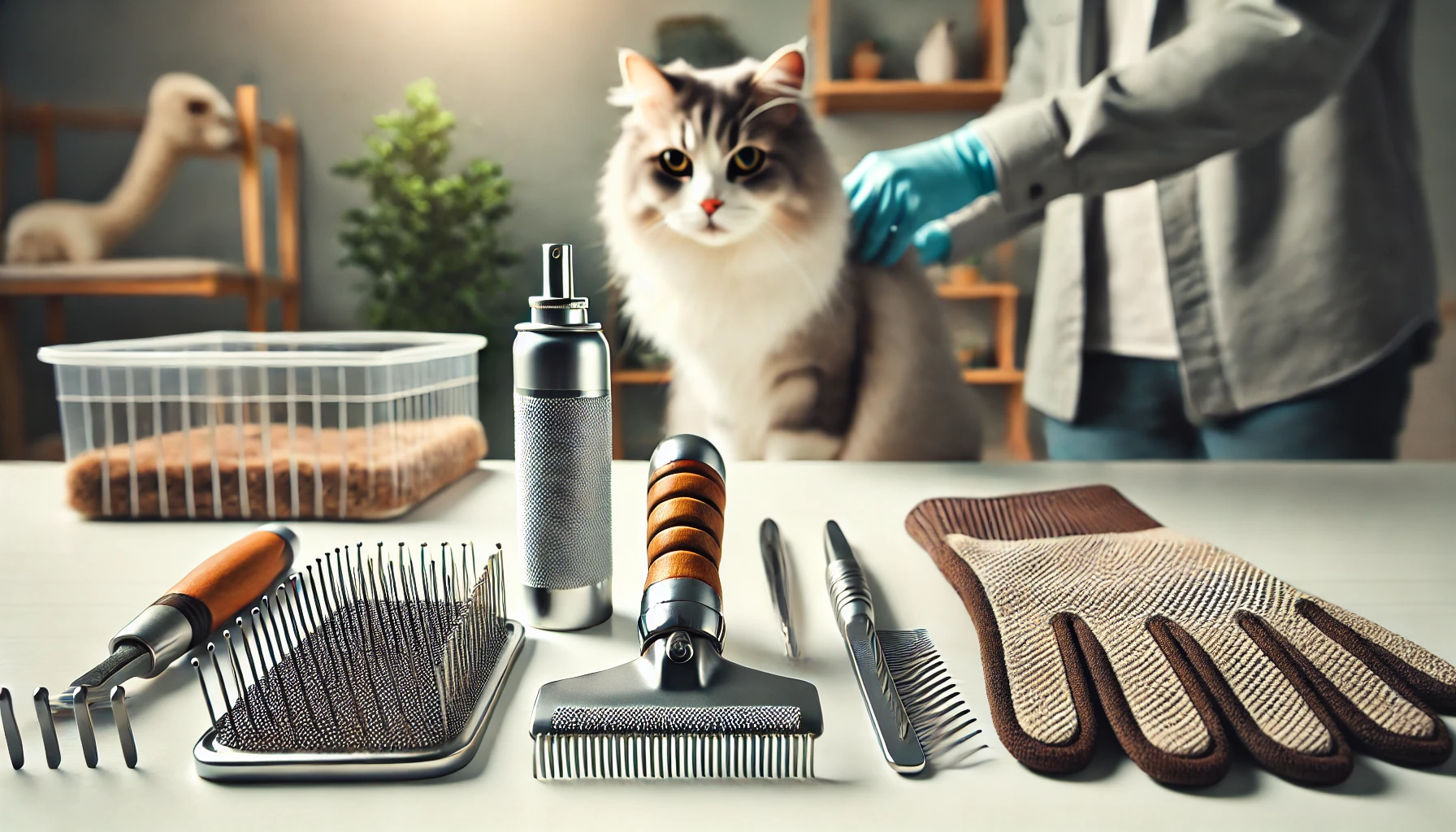
Combs, De-shedding Tools, and Gloves
Besides brushes, combs and de-shedding tools can be very helpful in managing excessive cat shedding.
A de-shedding tool, such as a Furminator, is specifically designed to reach the undercoat and remove loose hair before it ends up on your furniture.
These tools are particularly useful during heavy shedding seasons.
Grooming gloves are another excellent alternative, combining grooming with petting to make the process more enjoyable for your cat.
Gloves are especially suitable for cats that dislike brushes, as they feel more like a massage.
- De-shedding tool: Removes loose fur from the undercoat and significantly reduces shedding.
- Grooming gloves: Ideal for sensitive cats, offering gentle grooming through a petting-like experience.
- Metal comb: Useful for detangling fur and reaching the undercoat without causing discomfort.
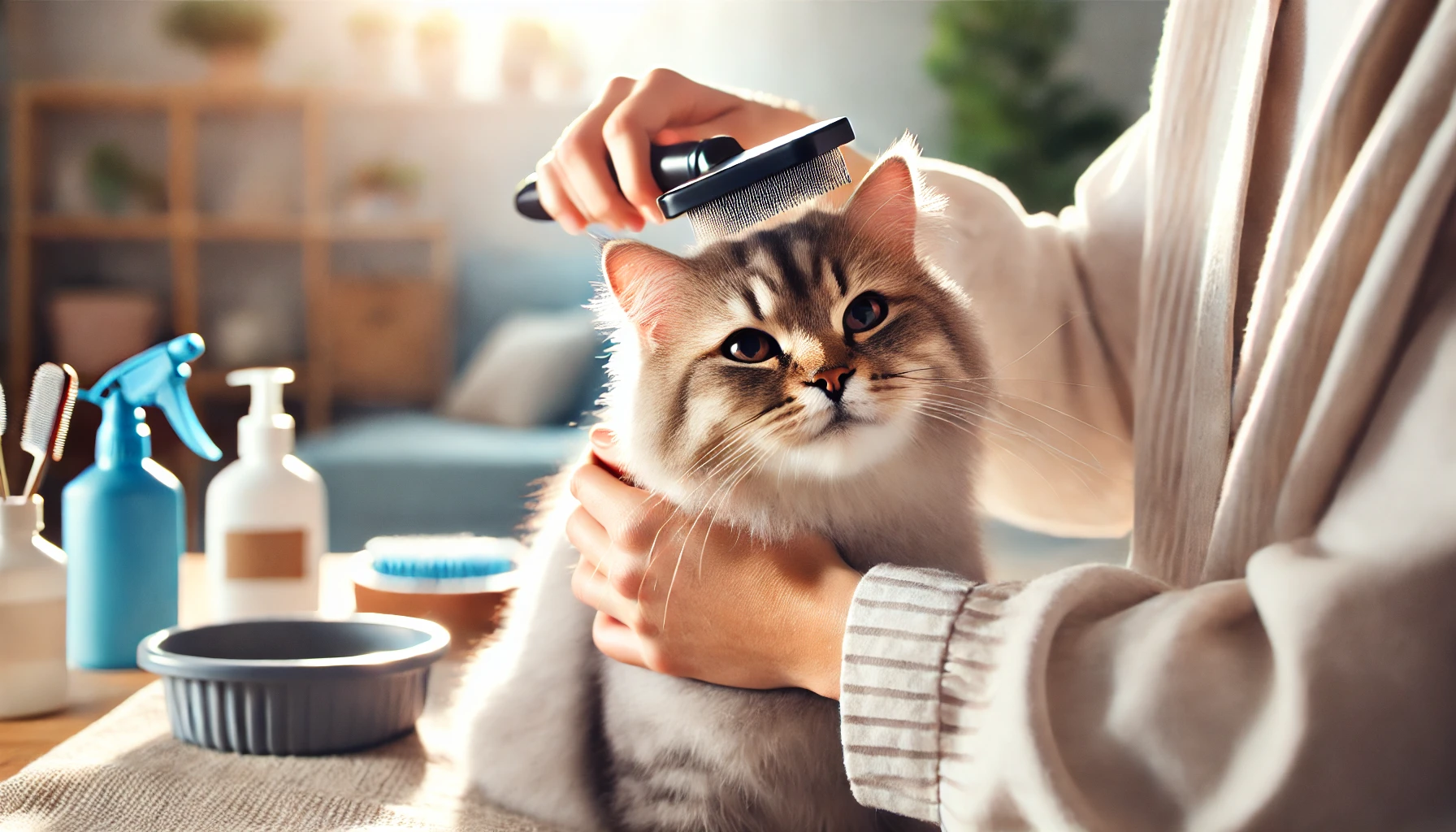
Benefits of Regular Grooming
Regular grooming helps control cat shedding and keeps your cat’s coat healthy.
Grooming stimulates your cat’s skin, promotes healthy hair growth, and distributes natural oils throughout the fur, keeping it shiny and soft.
Additionally, regular grooming can reduce the risk of hairballs, which form when cats swallow loose fur during self-grooming.
Grooming sessions also provide an opportunity to check for skin irritations, lumps, or parasites, allowing you to address potential health issues early.
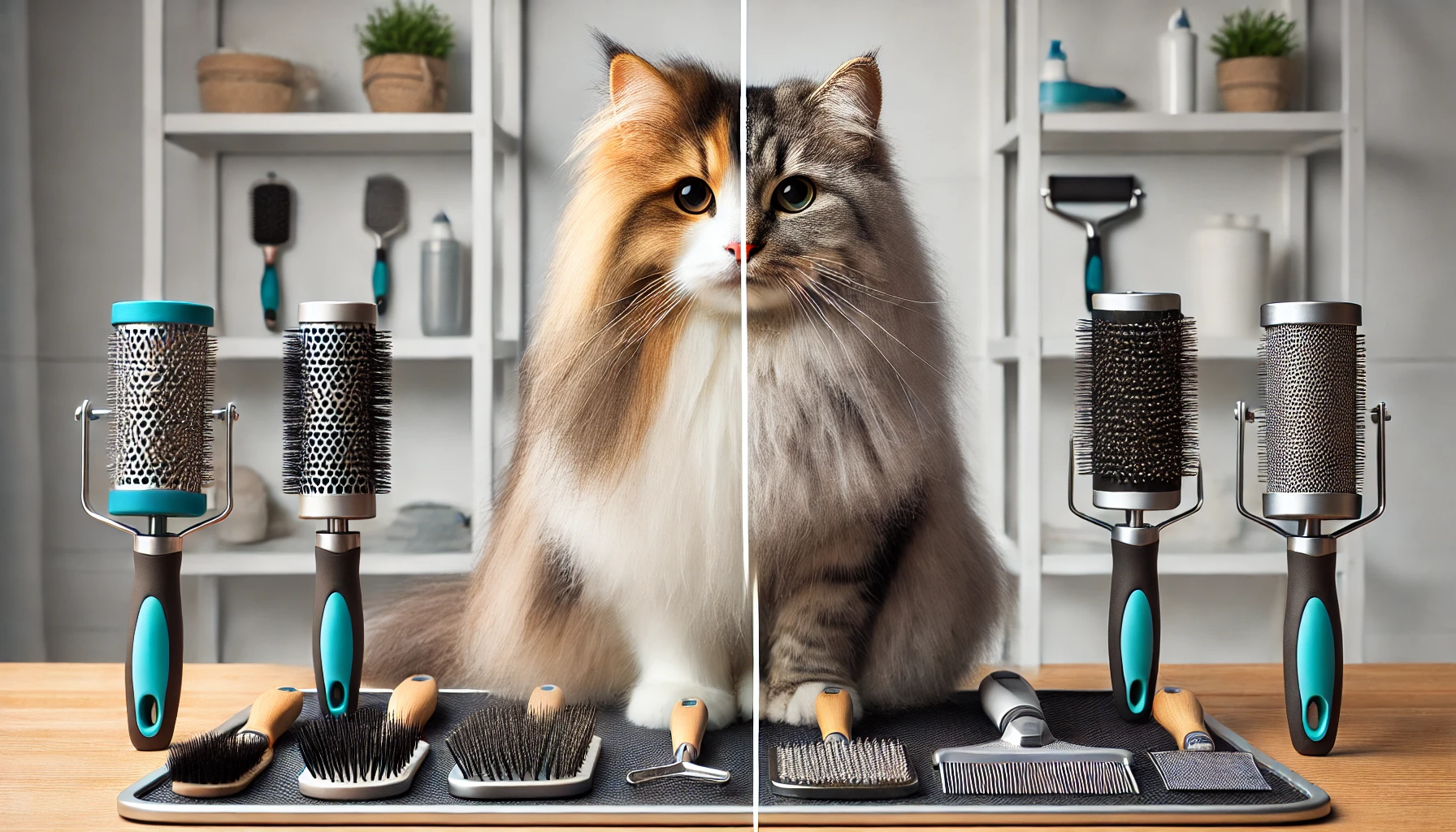
Tools for Long-Haired vs. Short-Haired Cats
Long-haired cats require more frequent grooming than short-haired cats to prevent matting and tangling.
In addition to a slicker brush, a wide-toothed comb is helpful for detangling long-haired breeds.
Short-haired cats may only need brushing once or twice a week.
A combination of a bristle brush and a rubber brush is usually sufficient to remove loose fur and maintain a clean, healthy coat.
- For long-haired cats: A slicker brush and wide-toothed comb for detangling and de-matting.
- For short-haired cats: A bristle or rubber brush to remove loose fur.
Using the right grooming tools, such as brushes, de-shedding tools, and combs, helps manage cat shedding effectively. Regular grooming also provides an opportunity to inspect your cat for any fur or skin abnormalities.

Tips to Reduce Cat Shedding at Home
Though complete avoidance of cat shedding is not possible, there are a number of tips you can try to lessen the loose fur that regularly circulates around your home.
Managing cat shedding starts with good health care, proper nutrition, and creating a regular grooming routine for your cat.
By following these tips, you can greatly reduce the amount of shedding and keep your home fur-free.
Let’s dive into how to reduce cat shedding.

Feeding Your Cat a Balanced Diet
A cat’s diet is a critical determinant of how healthy their coat and skin will be.
Cats need a nutrient-rich diet with essential fatty acids like omega-3 and omega-6.
These nutrients help reduce shedding by promoting a shiny coat and preventing dry, flaky skin that can lead to extreme shedding.
Your cat’s food should contain a high content of protein and healthy fats.
Poor nutrition is usually associated with dull, brittle fur and excessive shedding.
You might also want to add fish oil or flaxseed oil to your cat’s diet, as both have been proven to encourage coat health.
- Omega-3 and Omega-6 fatty acids: Important for the health and shine of the coat.
- Protein-rich diet: Boosts hair growth and reduces fur breakage.
- Fish oil supplements: Ensures good coat condition and reduces excessive shedding.
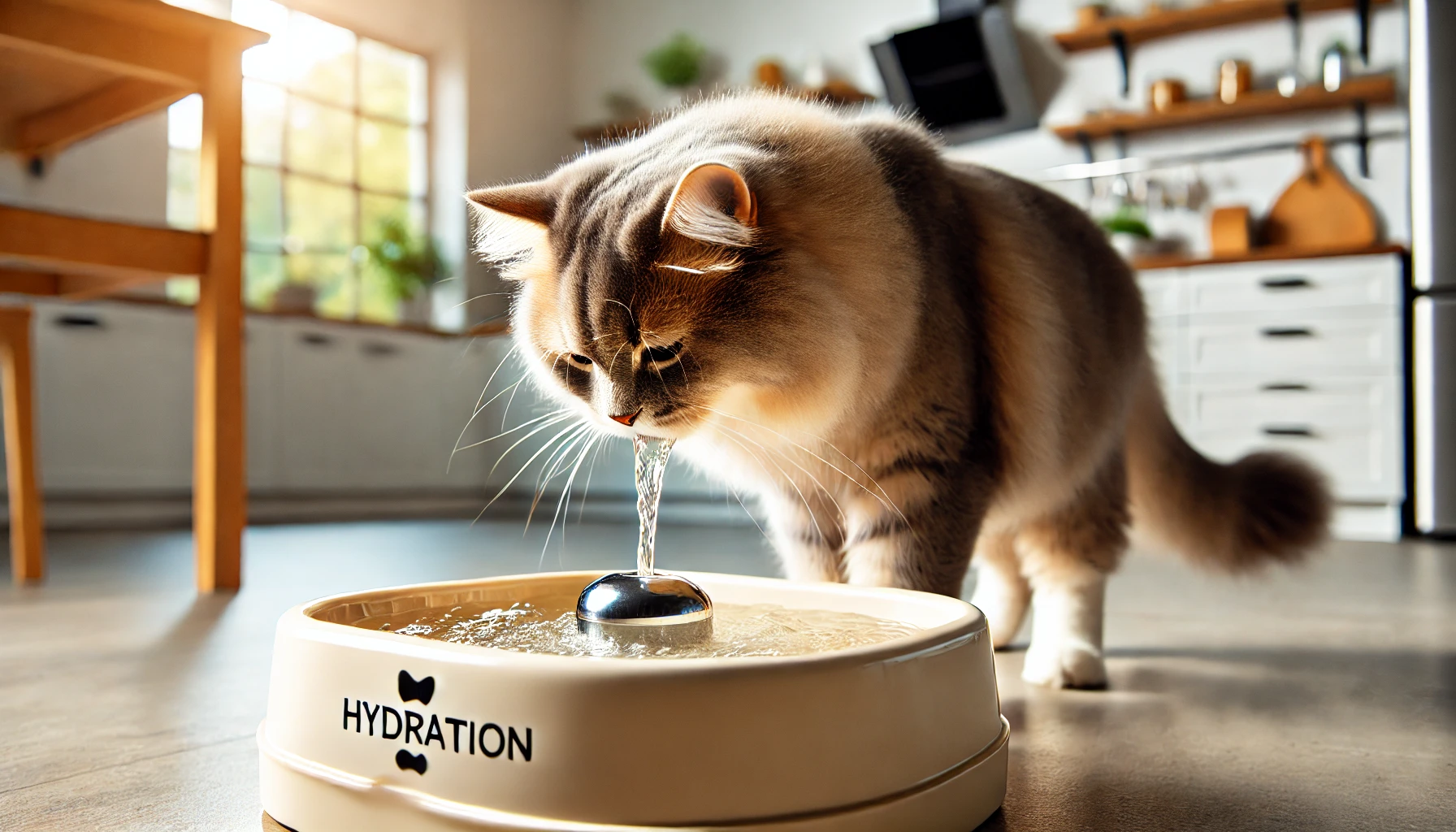
Hydration and Its Impact on Shedding
Hydration plays a major role in reducing the amount your cat sheds.
When cats are dehydrated, they develop dry skin, which encourages more shedding.
Ensure your cat has access to fresh water at all times.
Some cats prefer drinking from a fountain because running water encourages them to drink more.
Wet food can also help maintain hydration levels, especially in cats that don’t drink water often.
A well-hydrated cat will have healthier skin and fur, resulting in less shedding.
- Hydrate with fresh water: Ensure that water bowls are full and clean at all times.
- Wet food: Increase the amount of wet food your cat consumes for better hydration.
- Cat fountains: Encourage cats to drink more water to promote better hydration.
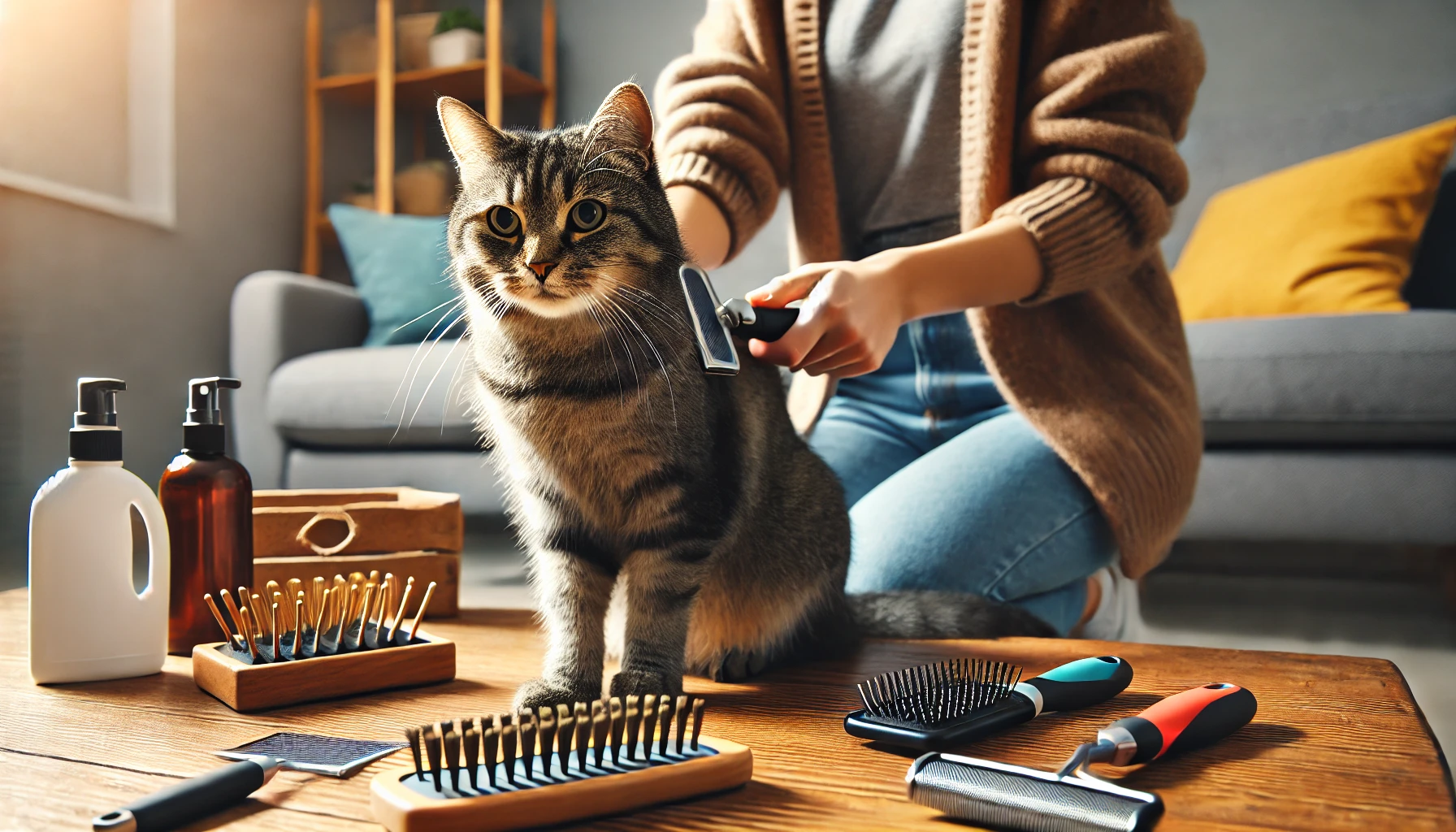
Creating a Regular Grooming Schedule
One of the best ways to keep cat shedding to a minimum is through regular grooming.
Brushing your cat at least a few times a week can significantly reduce the amount of loose fur.
Regular grooming prevents loose hair from spreading throughout your home and reduces the likelihood of mats and tangles, especially in long-haired cats.
Depending on your cat’s fur type, you may need to brush them more or less frequently, but consistency is key in controlling shedding.
- Regular brushing: Try to brush your cat several times a week.
- Using the proper tools: Use a brush suited to your cat’s fur type for maximum effectiveness.
- Focus on problem areas: Pay extra attention to the belly, legs, and other areas where shedding is most noticeable.
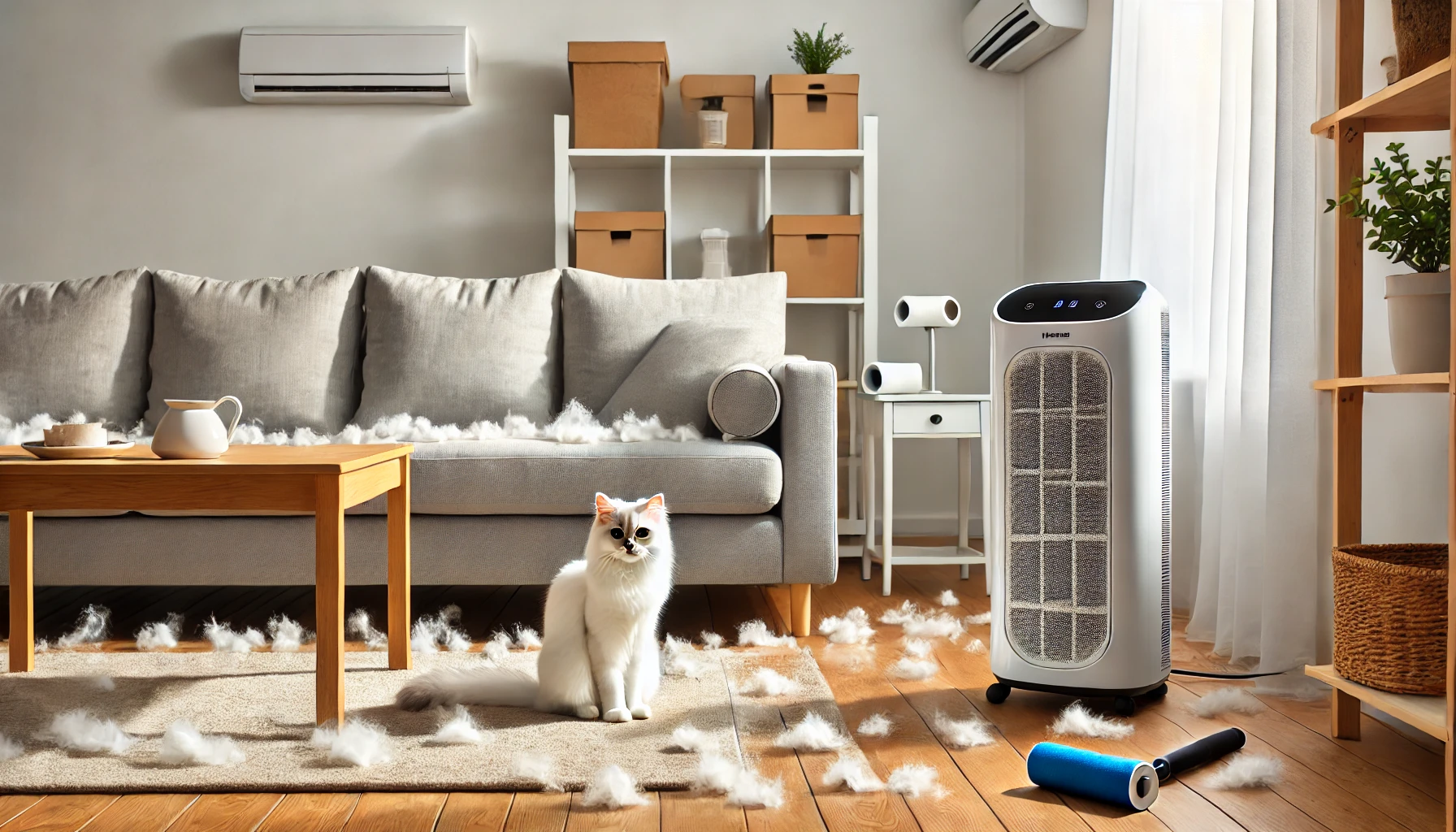
How to Minimize Shedding Through Environmental Control
Your cat’s surroundings can also impact shedding.
Cleaning your home regularly can help reduce the buildup of allergens and loose fur.
Vacuuming frequently and using washable furniture covers can minimize the accumulation of cat hair.
Additionally, controlling the temperature and humidity in your home can make a difference.
Cats tend to shed more in warm environments, so keeping your home at a cool, comfortable temperature can reduce excessive shedding.
- Regular cleaning: Vacuum more frequently to remove loose fur from floors and furniture.
- Furniture covers: Use washable furniture covers to reduce fur buildup.
- Control temperature: Keep your home cool but comfortable to minimize shedding.
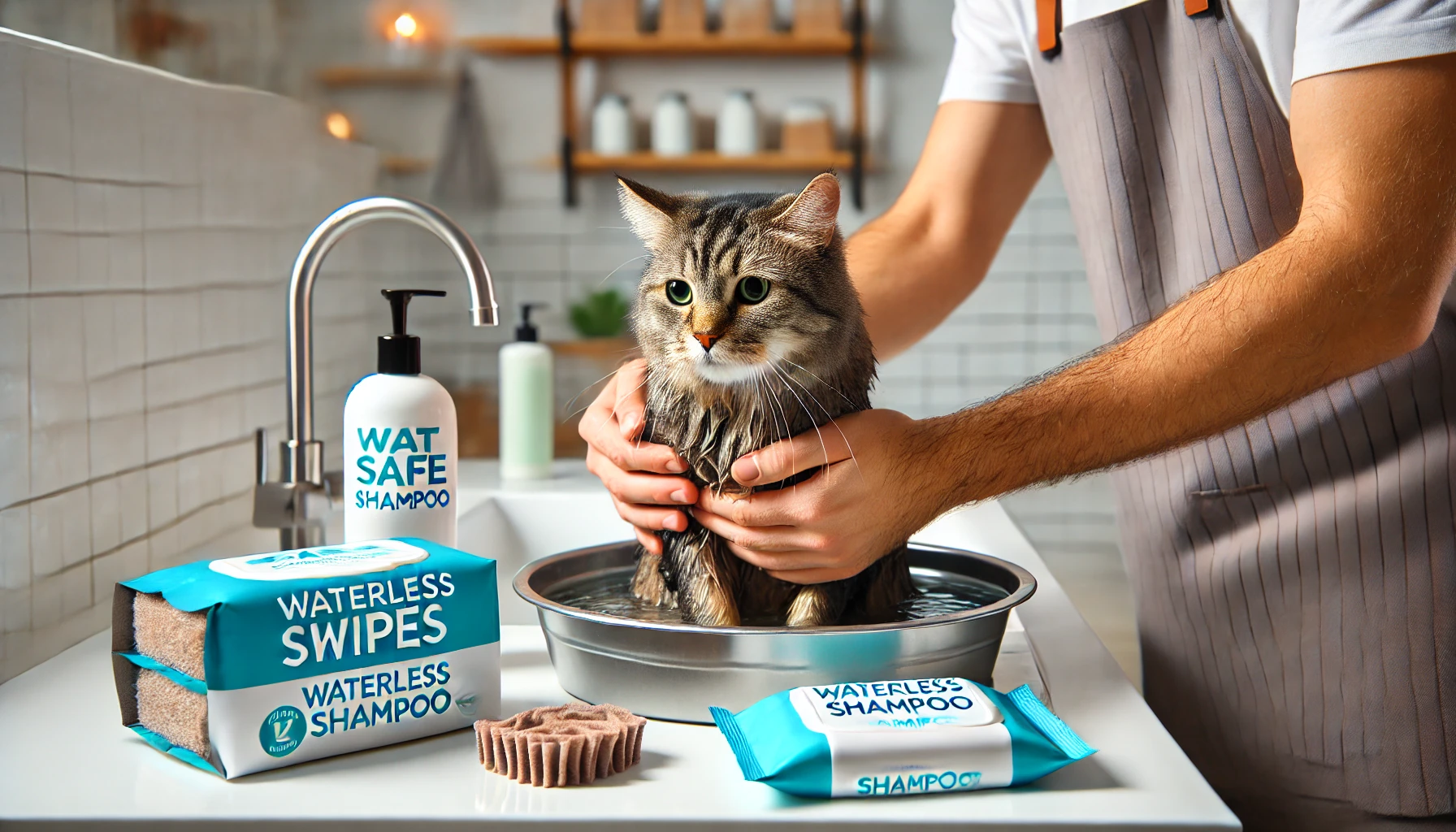
Bathing and Shampoo Tips to Control Shedding
Although cats generally don’t need frequent baths, occasional bathing can help reduce shedding, especially during high shedding seasons.
Use a cat-safe shampoo formulated to promote skin and coat health.
Bathing helps remove dead skin cells and loose fur, reducing the amount of hair your cat sheds.
If your cat dislikes baths, consider using waterless shampoos or grooming wipes as alternatives to help control shedding.
- Cat-safe shampoo: Use shampoos designed specifically for cats to promote coat health.
- Bathing schedule: Bathe your cat only when necessary, typically every few months.
- Grooming wipes: For cats that dislike bathing, grooming wipes can help remove loose fur effectively.
Proper nutrition and hydration are key to reducing cat shedding. Ensuring your cat consumes a diet rich in essential fatty acids like omega-3 and omega-6 can improve coat health and reduce the amount of shedding.
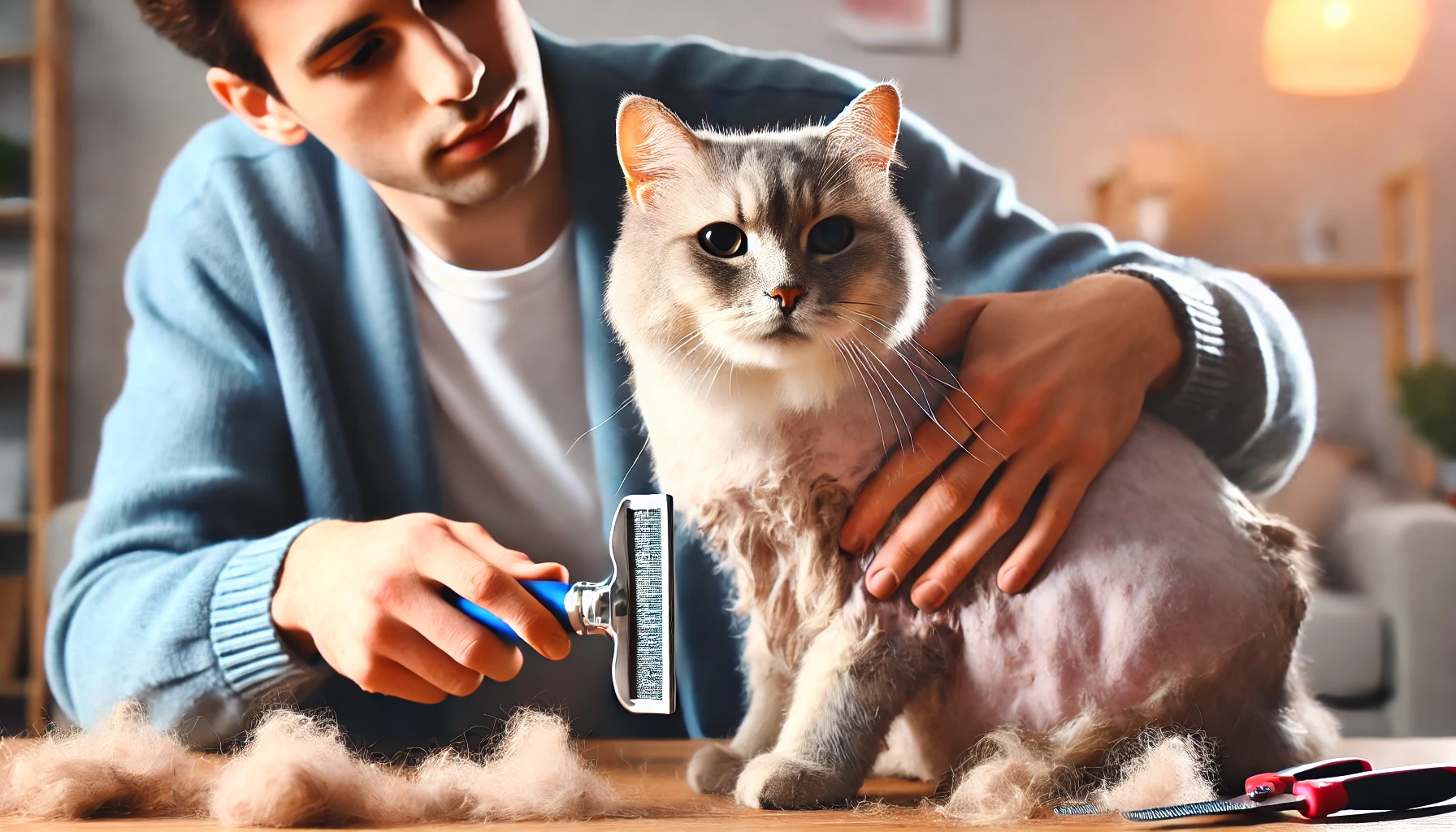
Health Issues Due to Excessive Cat Shedding
While cats shed due to a natural process, excessive cat shedding may be indicative of an underlying health problem.
If your cat sheds more than normal or has bald spots, something may be going wrong.
Being on the lookout for these potential health concerns will help you take early action to ensure that your cat remains healthy.
Let’s explore some common health problems that cause excessive shedding and how to address them.
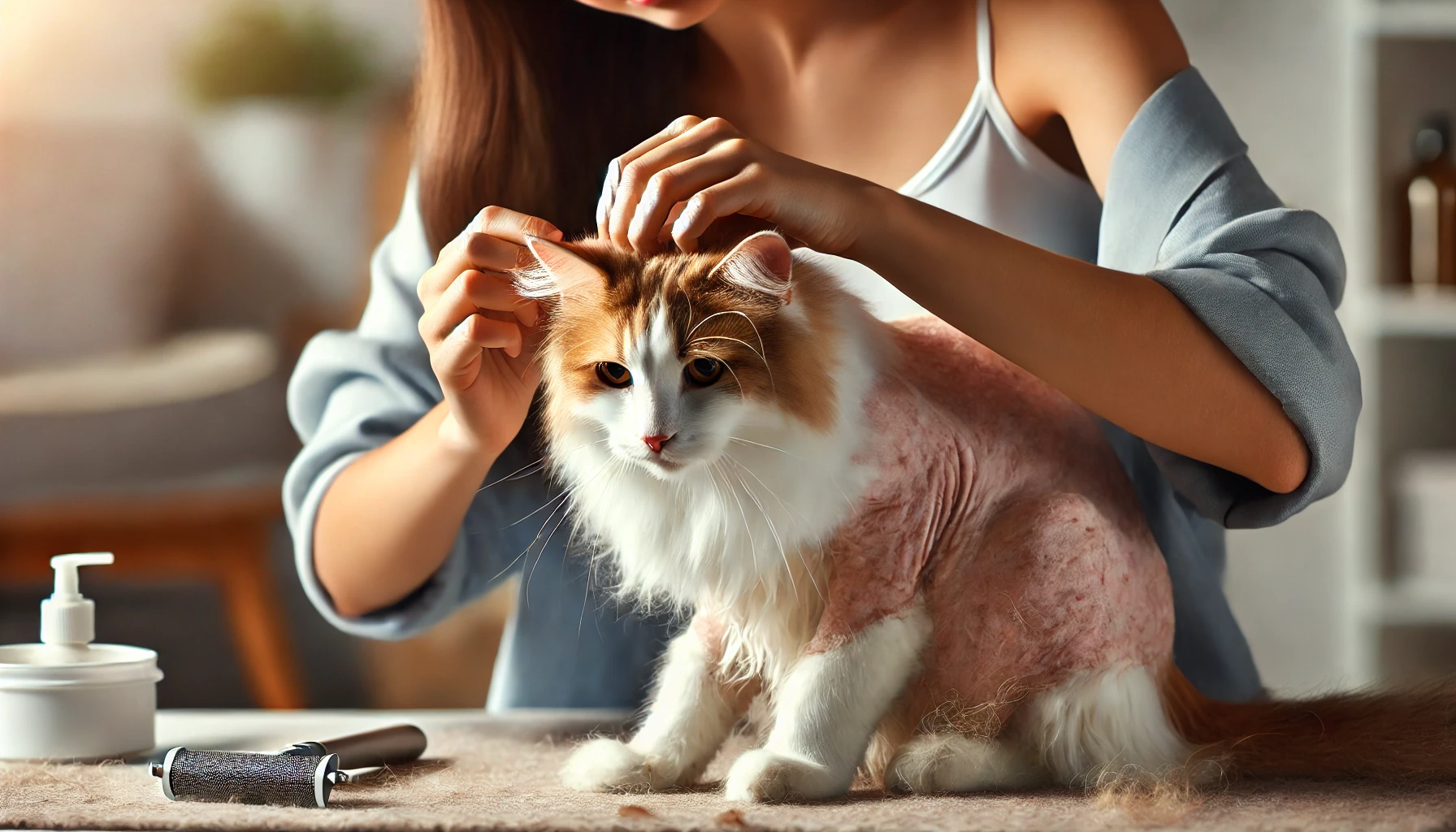
Recognizing Skin Conditions
Skin conditions are among the most common causes of excessive shedding in cats.
Dermatitis, fungal infections, and bacterial infections can result in skin irritation, leading to hair loss.
These conditions may cause your cat to scratch or lick excessively, which can further damage the skin and result in more shedding.
Additionally, dry skin, dandruff, and allergic reactions can also cause excessive fur loss.
If you notice your cat grooming or scratching excessively, it’s important to check their skin for any redness, swelling, or flakiness.
- Dermatitis: Inflammation of the skin, often caused by allergies or irritants, leading to hair loss.
- Fungal infections: Ringworm is a common fungal infection that causes circular spots of hair loss.
- Dry skin: Lack of hydration, poor nutrition, or environmental factors can result in flaky skin and increased shedding.
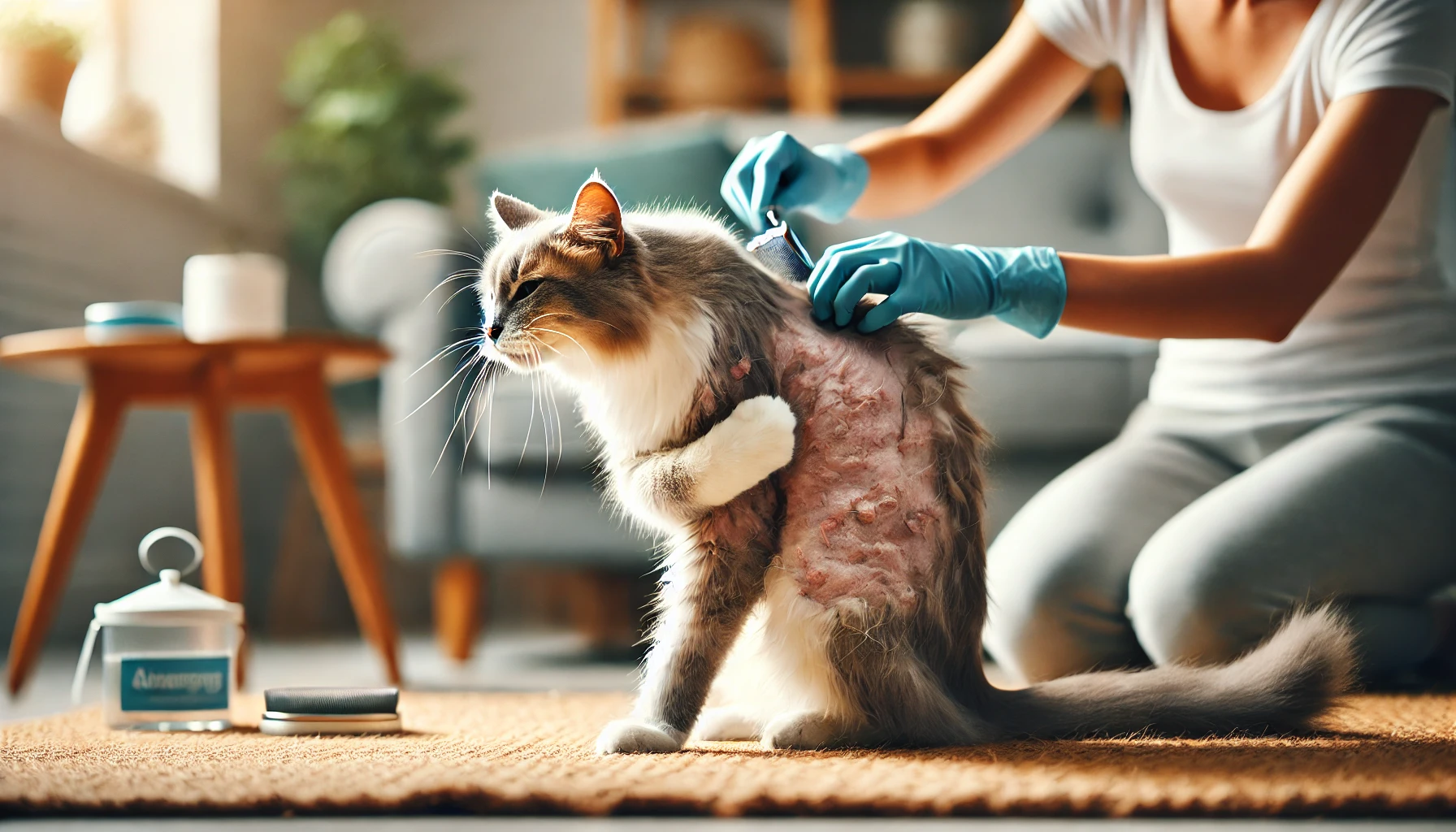
Allergies and Their Contribution to Shedding
Another common cause of excessive cat shedding is allergies.
Cats can show allergic reactions to a variety of elements, such as food, pollen, dust, or even some cleaning agents.
These allergic reactions often cause itchy skin, prompting the cat to scratch or over-groom, which can result in hair loss.
If you suspect your cat has allergies, it’s important to work with your vet to determine the specific allergen so you can make necessary changes to your cat’s diet or environment.
- Food allergies: Can lead to skin irritation and hair loss; a hypoallergenic diet may help resolve the issue.
- Environmental allergies: Pollen, dust, or mold can cause excessive grooming and shedding in allergic cats.
- Contact allergies: Certain fabrics or cleaning products can irritate your cat’s skin, leading to hair loss.
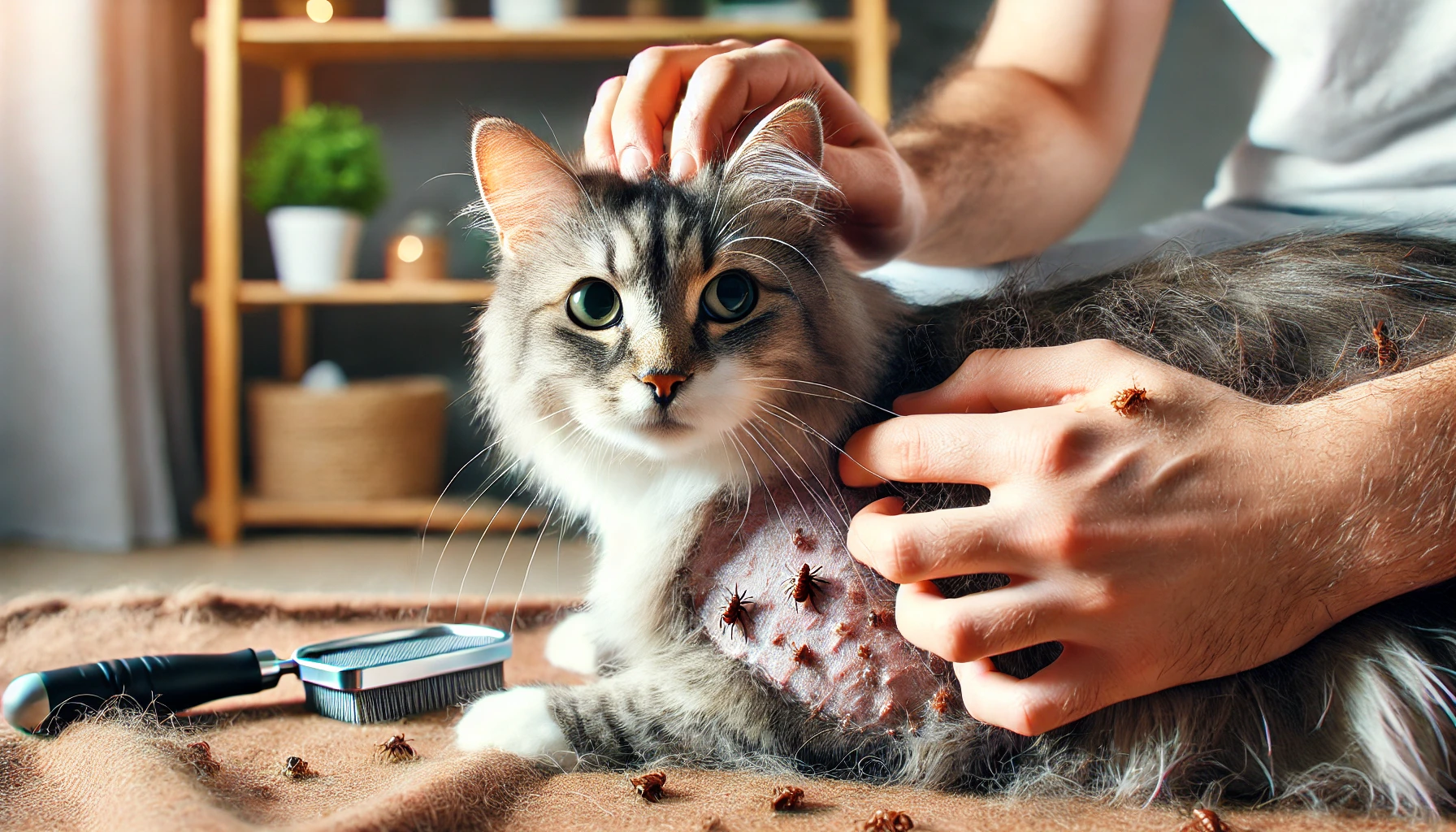
Parasites and How They Affect Hair Loss
In addition to health issues, parasites like fleas, mites, and ticks can also cause excessive shedding in cats.
These tiny pests can cause severe itching, leading to aggressive scratching and eventual hair loss.
Flea infestations are especially common and can lead to flea allergy dermatitis, a hypersensitive reaction to flea bites.
Mites and ticks can also cause irritation and shedding.
It is important to regularly check your cat for signs of parasites, especially if they spend time outdoors.
- Fleas: Can cause severe itching and flea allergy dermatitis, leading to thinning of hair.
- Mites: Mange mites can cause hair thinning and skin irritation.
- Ticks: Can cause localized irritation and hair loss at the site of attachment.
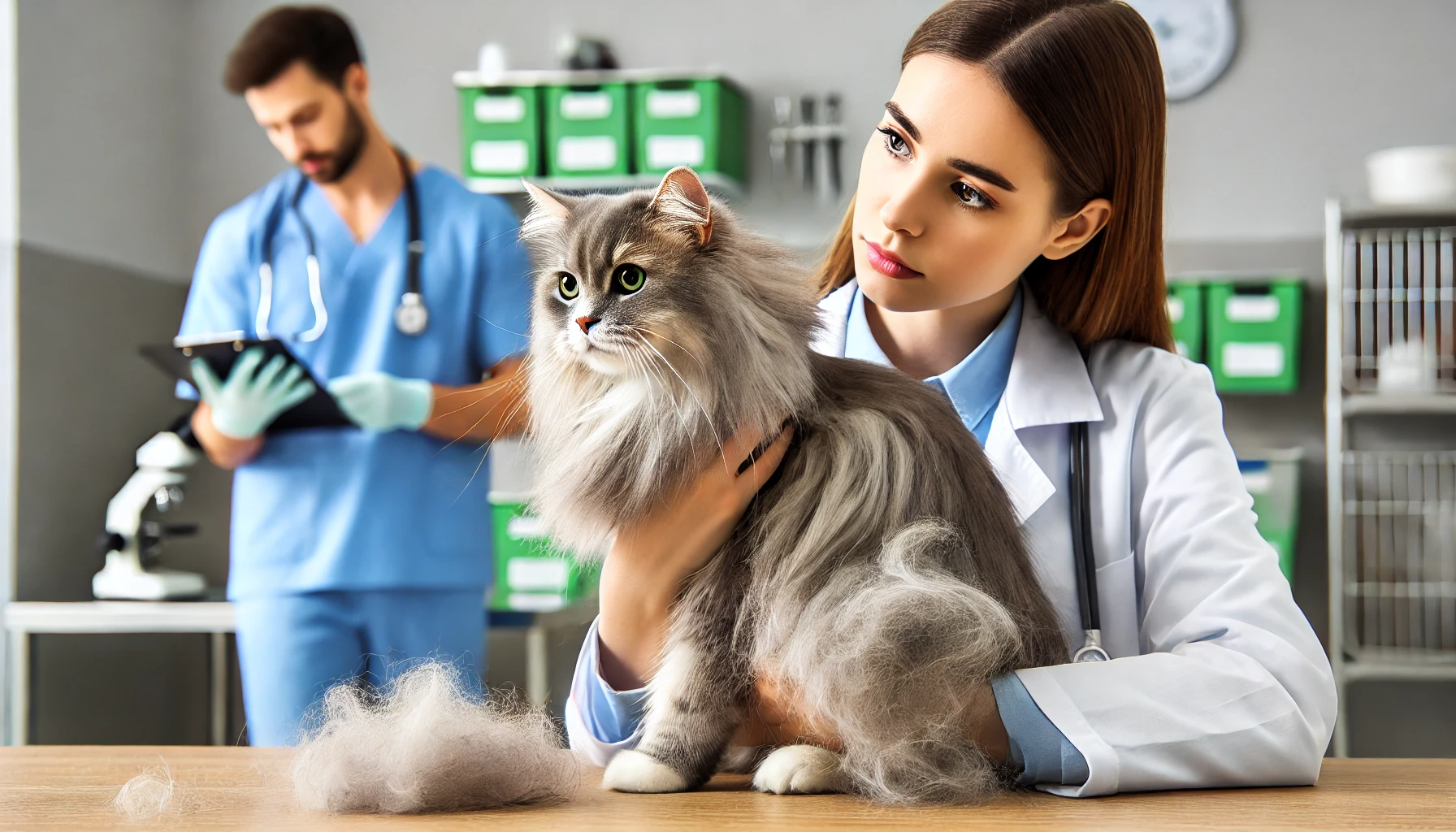
When to See a Vet About Shedding
It’s essential to know when excessive shedding requires veterinary attention.
If you notice your cat experiencing sudden or severe hair loss, bald patches, or if their skin looks inflamed, it’s time to consult a vet.
Other warning signs include constant scratching, licking, or grooming that doesn’t seem to stop.
A vet can conduct tests to determine the cause of the excessive shedding, whether it’s due to allergies, skin conditions, or parasites.
Early diagnosis and treatment can help prevent further hair loss and maintain your cat’s health.
- Sudden hair loss: Seek vet care if your cat suddenly starts losing large amounts of fur or develops bald patches.
- Skin inflammation: Red, swollen, or flaky skin is a sign of a potential underlying health issue.
- Excessive grooming: Constant licking or scratching may indicate an allergy or parasitic infestation.
Excessive shedding could indicate underlying health problems such as dermatitis, fungal infections, or parasites. Regularly checking your cat’s skin for signs of irritation can help detect these issues early.
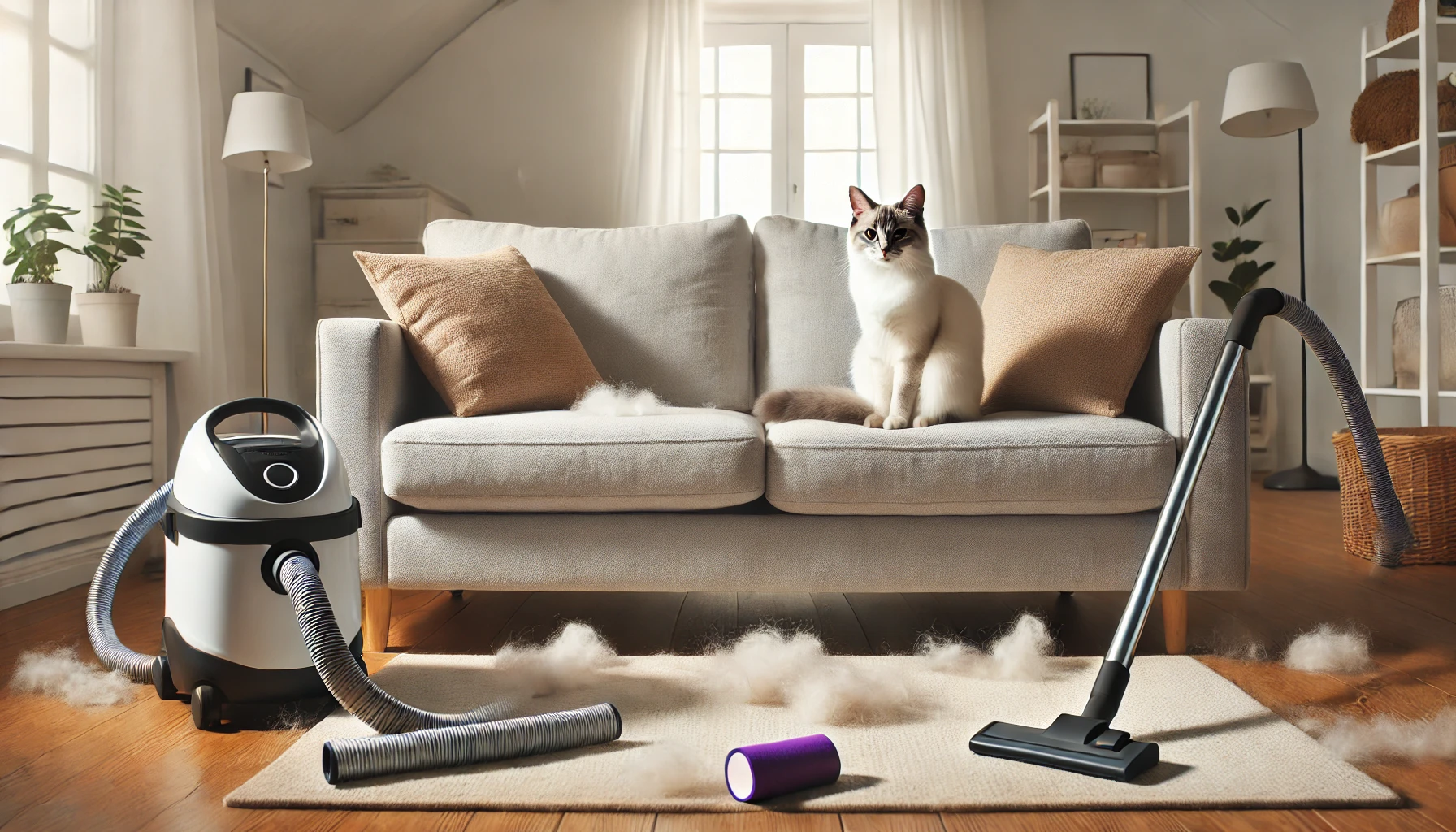
Preventing Shedding-Related Issues Within the Home
Though cat shedding may seem hectic and uncontrollable, there are several ways to minimize the issues that come with it in your home.
By keeping your surroundings clean and using the right tools or products, you can reduce the impact of loose fur and create a more comfortable living space for you and your cat.
This section explores practical tips to prevent shedding-related issues around your home.
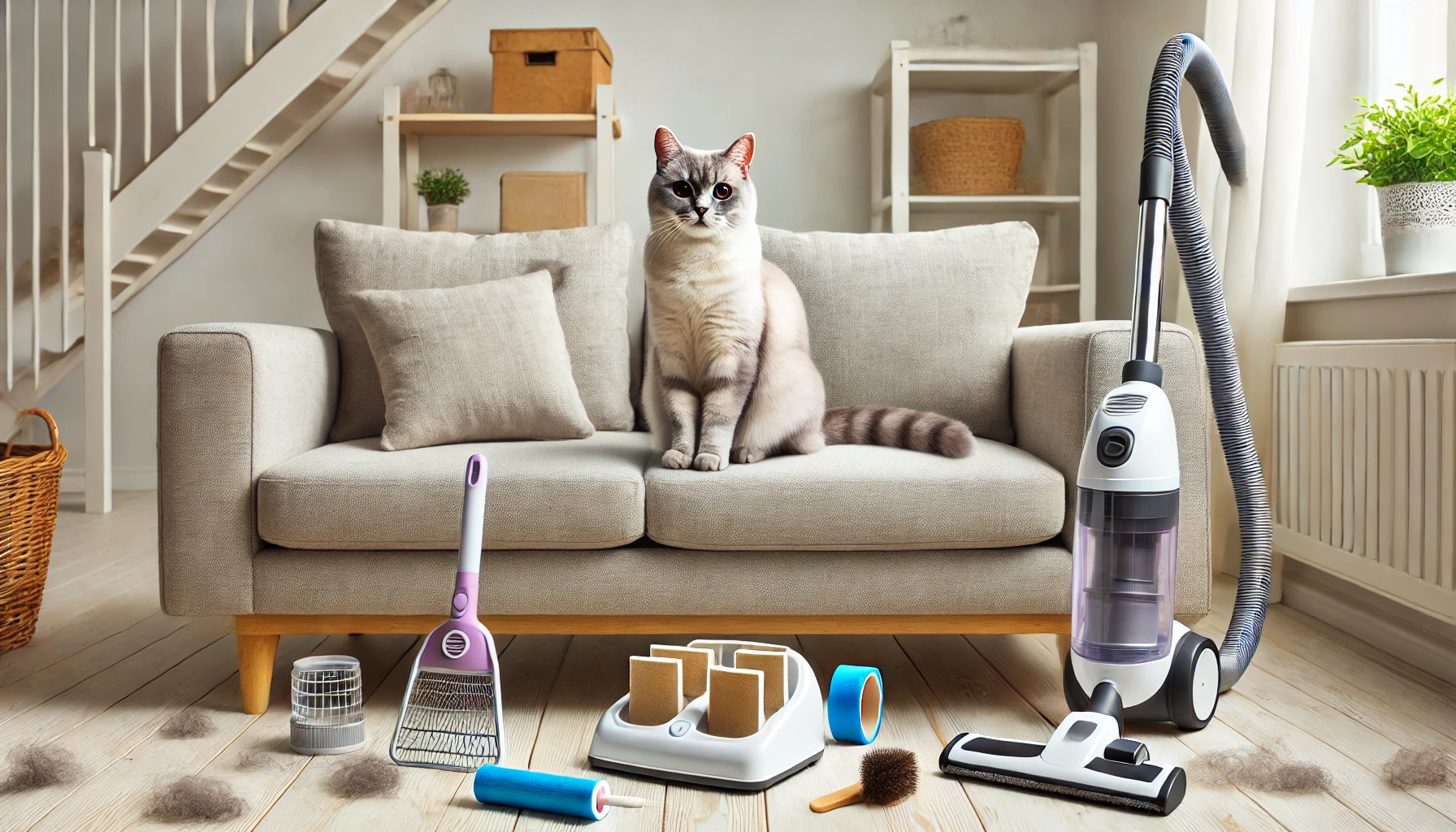
How to Manage Cat Hair in the House
The best way to deal with cat shedding is regular cleaning of your house.
First, you will need to vacuum regularly, especially in areas where your cat tends to stay.
It is preferable to use a vacuum cleaner designed for pet hair, as these models come with special filters and nozzles that pick up hair more effectively.
In addition to vacuuming, using lint rollers or pet hair removers on furniture and clothing can help manage loose fur.
Washing your cat’s bedding regularly also helps prevent hair buildup.
- Vacuuming: Use a vacuum designed for pets with attachments made for picking up fur.
- Lint rollers: Keep lint rollers handy for quick clean-ups on clothing and furniture.
- Wash bedding: Wash your cat’s bedding regularly to prevent hair accumulation.
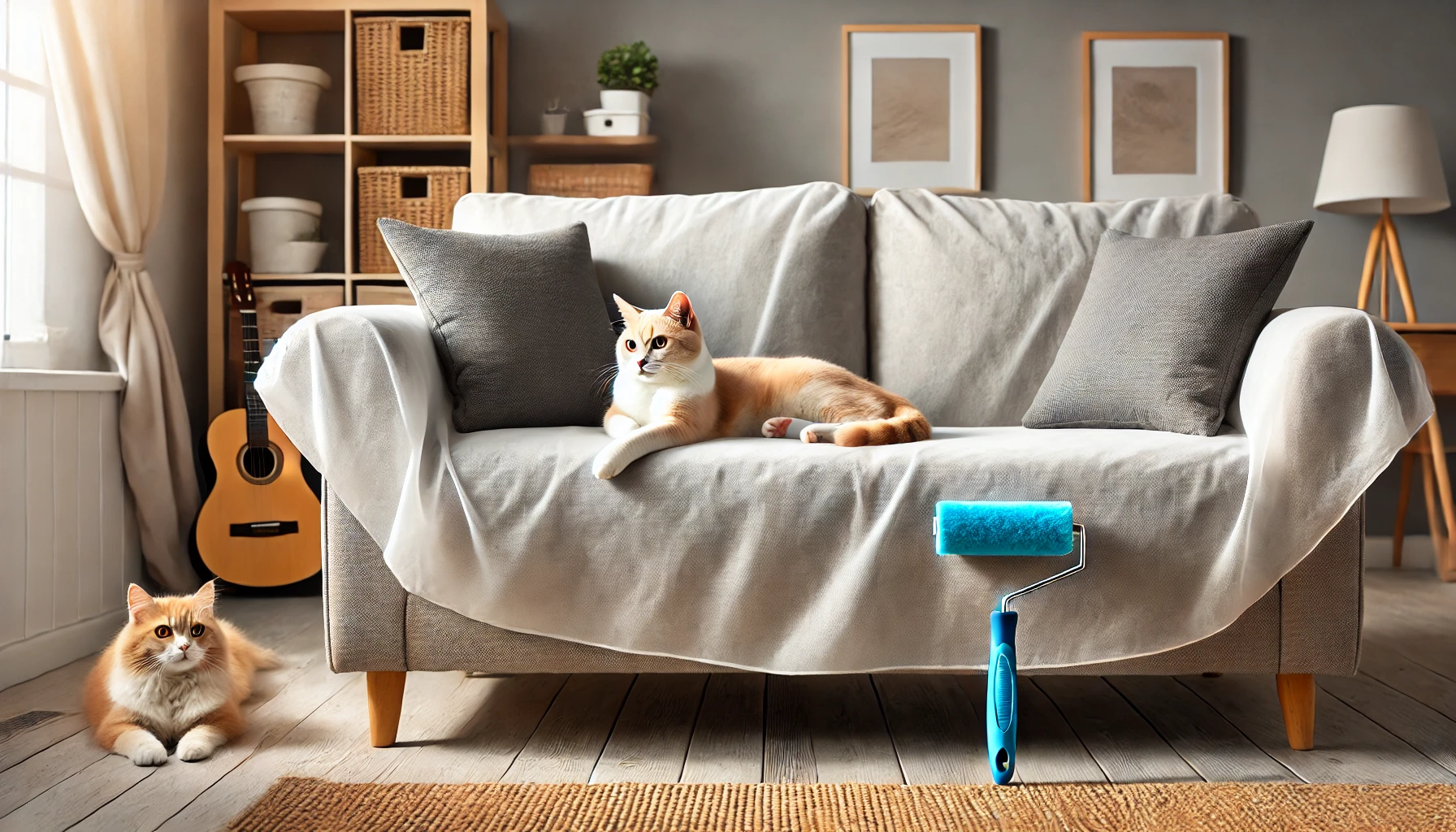
How to Keep Your Furniture and Clothing Fur-Free
Fur-covered furniture and clothing are common problems for cat owners.
However, with the right strategies, this can be minimized.
If your cat enjoys lounging on couches or chairs, furniture covers are a great option.
These covers are easy to remove and wash, making it easier to keep your furniture fur-free.
Additionally, using fabrics that are less likely to attract cat hair, such as leather or tightly woven materials, can help reduce the amount of fur on furniture.
For clothing, anti-static sprays and dryer sheets can help repel fur, making cleaning much easier.
- Furniture covers: Place washable covers on couches and chairs to catch loose fur.
- Fur-resistant fabrics: Choose fabrics like leather or tightly woven materials that do not cling to fur.
- Anti-static sprays: Apply to clothing to reduce fur attraction and make cleaning easier.
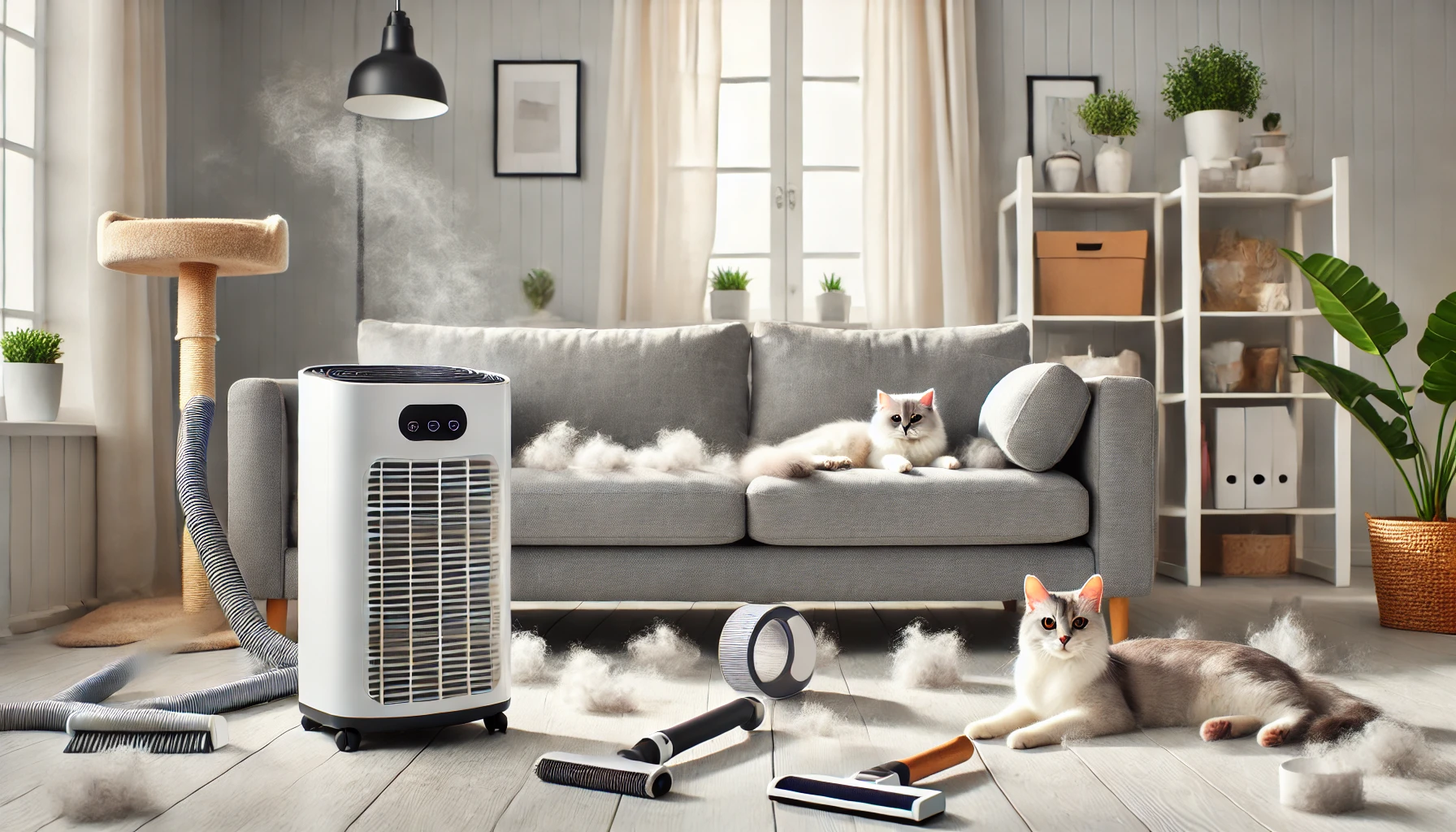
Air Purifiers and Cleaning Tools to Control Shedding
Air purifiers can be effective in controlling the spread of cat hair and dander.
Look for purifiers with HEPA filters, which are designed to trap pet hair and other allergens.
Using an air purifier regularly will reduce the amount of fur circulating in the air.
Additionally, investing in cleaning tools specifically designed for pet hair, such as pet-specific vacuums, grooming brushes, and hair removers, will help you stay on top of shedding.
- Air purifiers: Look for models with HEPA filters to capture pet hair and dander.
- Pet-specific cleaning tools: Use vacuums and other tools designed specifically for pet hair to make cleaning easier.
- Grooming tools: Regular grooming with the proper tools can reduce the amount of loose fur in your home.
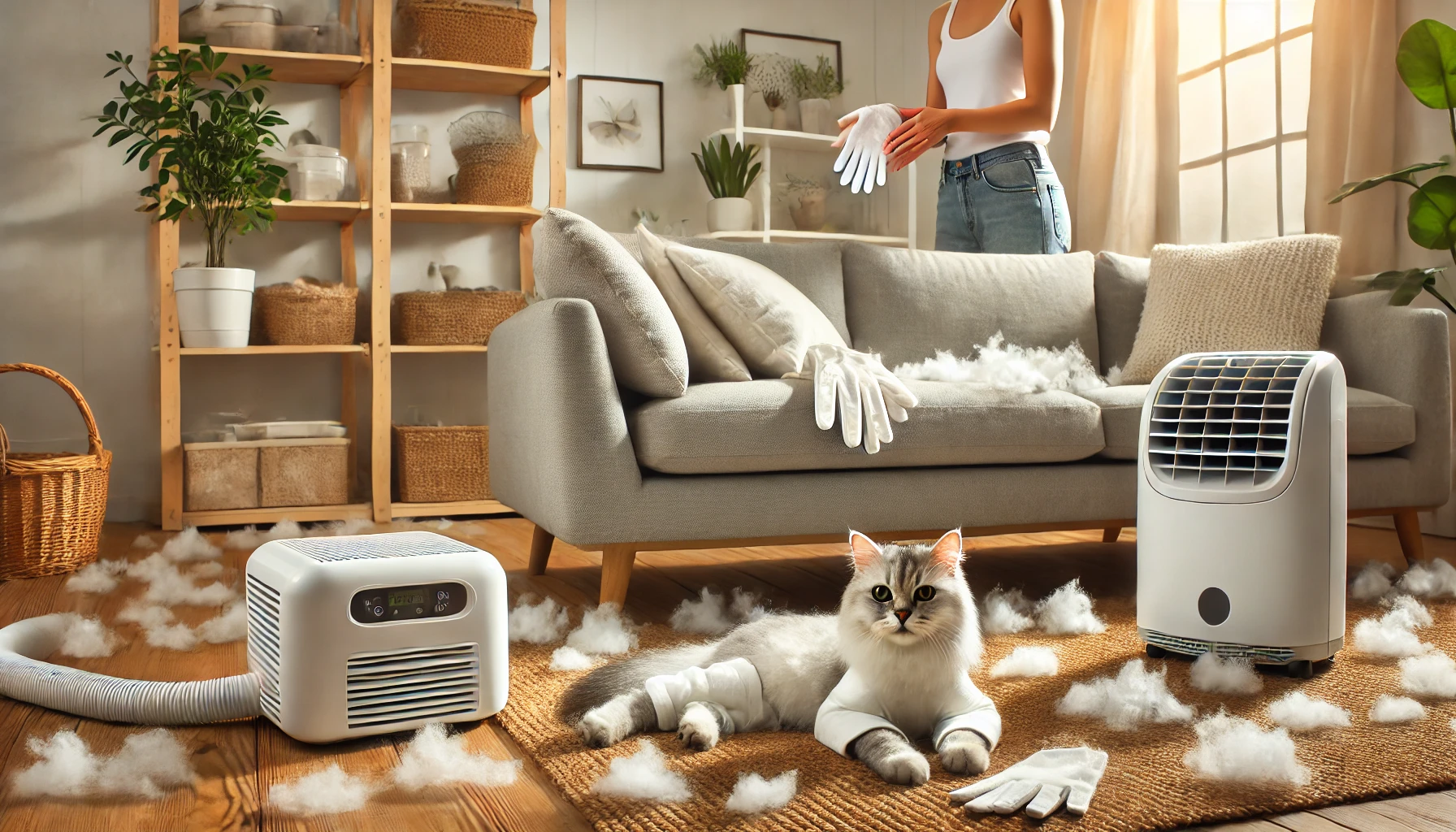
Shedding and Human Allergies: Reducing Exposure
For those who are allergic to cat fur or dander, managing shedding is essential to reducing allergic reactions.
In addition to regular grooming and using air purifiers, it’s important to minimize your exposure to loose fur.
Consider creating cat-free zones in your home, such as bedrooms or certain furniture areas, to reduce the amount of hair in these spaces.
Wash your hands after petting your cat, and use allergy-specific cleaning products to help reduce allergens in your environment.
If allergies persist, consult your doctor for possible treatments or medications.
- Cat-free areas: Establish cat-free zones in your home to reduce fur exposure.
- Hand washing: Wash your hands after interacting with your cat to reduce contact with allergens.
- Allergy-specific cleaning products: Use products designed to reduce allergens and pet hair in your home.
Regular cleaning, vacuuming, and using air purifiers can help manage the impact of cat shedding at home. Furniture covers and anti-static sprays are also useful tools in minimizing fur accumulation.
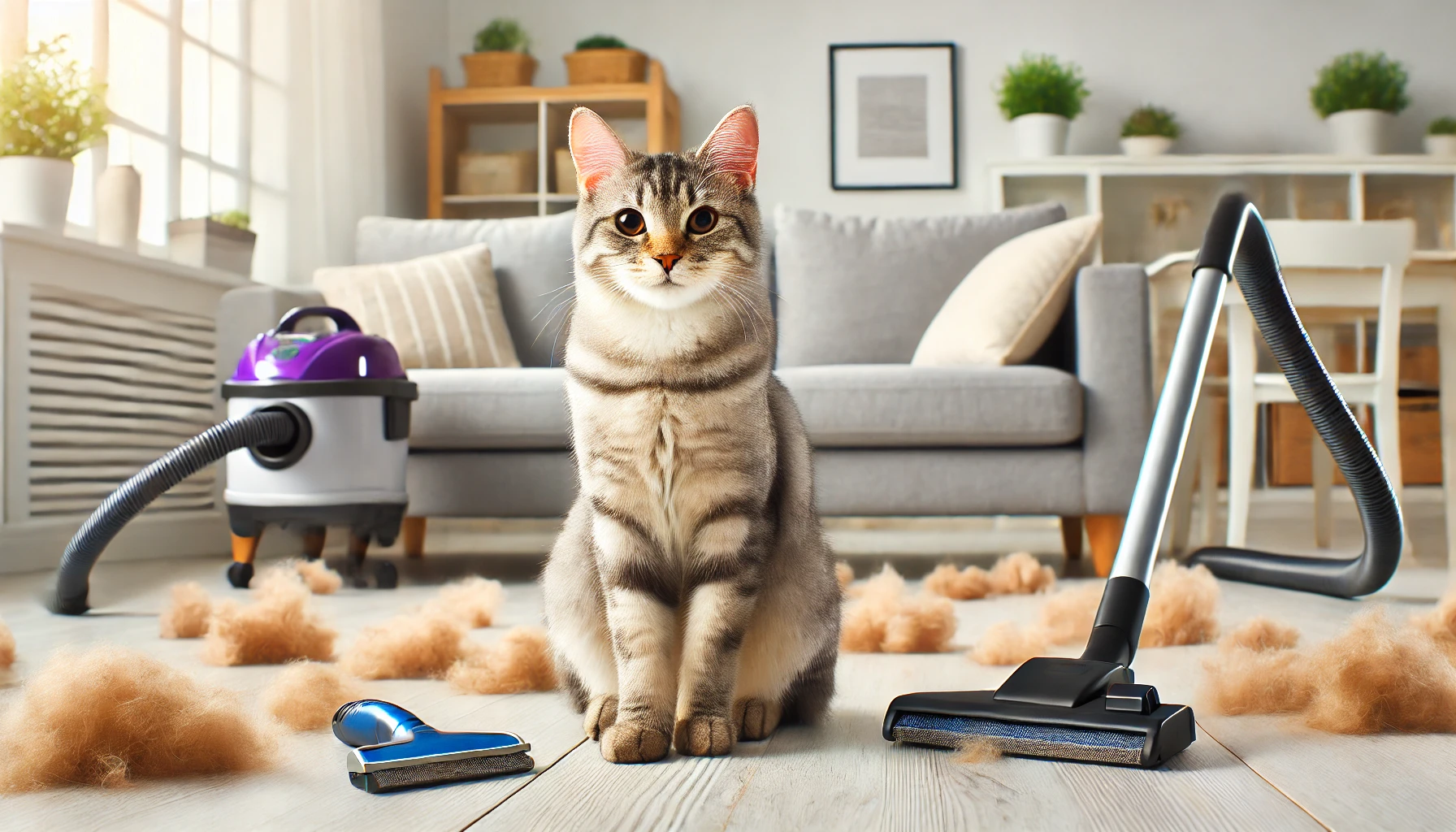
Conclusion: Effectively Managing Cat Shedding
Cat owners often regard managing cat shedding as a daunting task.
However, with the right tools, techniques, and knowledge, the job becomes much easier.
Shedding is a natural part of a cat’s life cycle, and while it’s impossible to completely eliminate shedding, it can certainly be brought under control.
In this article, we have covered the most important facts regarding cat shedding—from causes and health concerns related to excessive shedding to practical tips that help minimize shedding in your home.
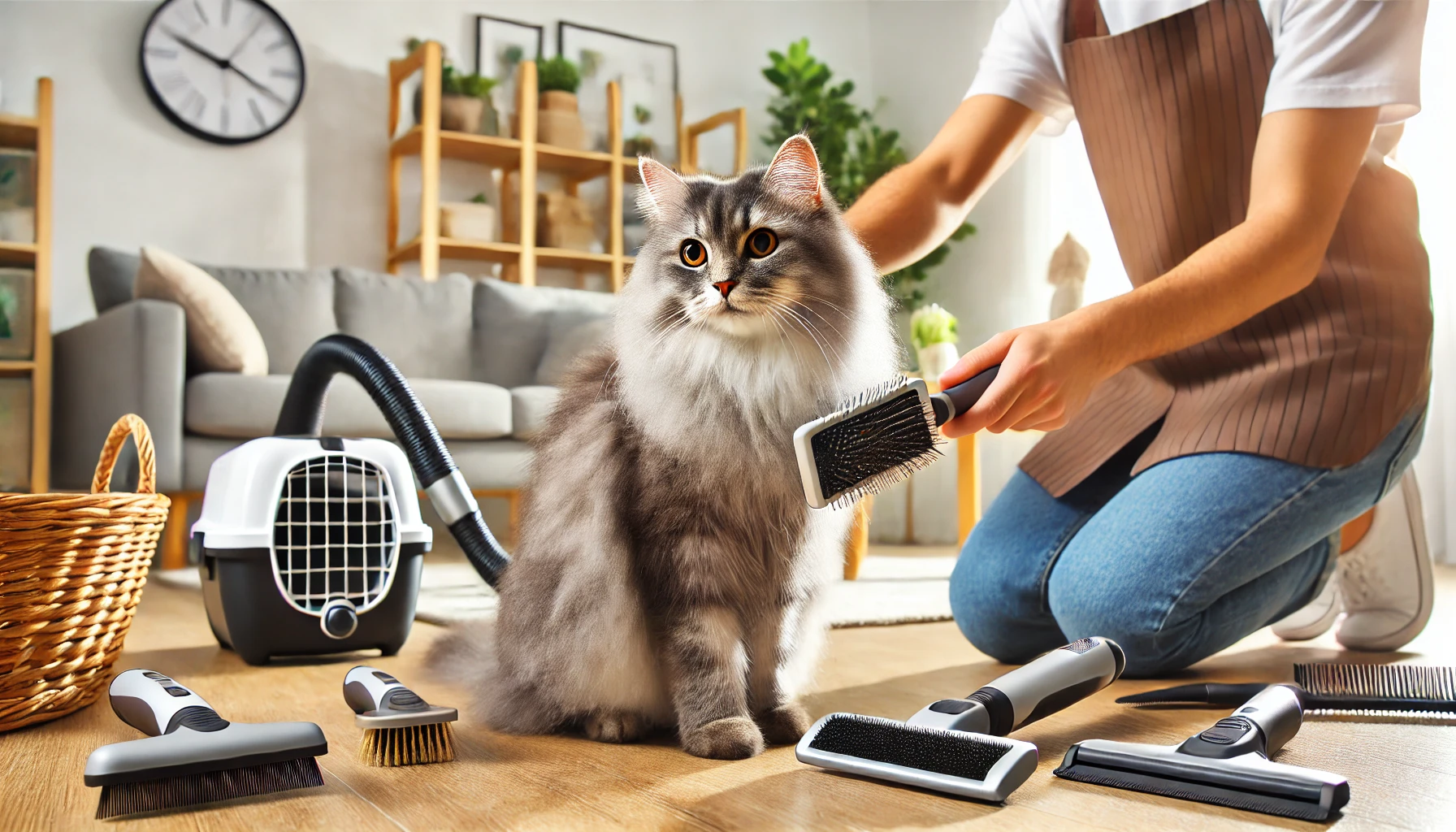
Key Points on Managing Cat Shedding
Below are some important strategies and practices to include in your routine to effectively manage cat shedding.
Here are key takeaways to help reduce shedding and keep your cat’s coat healthy:
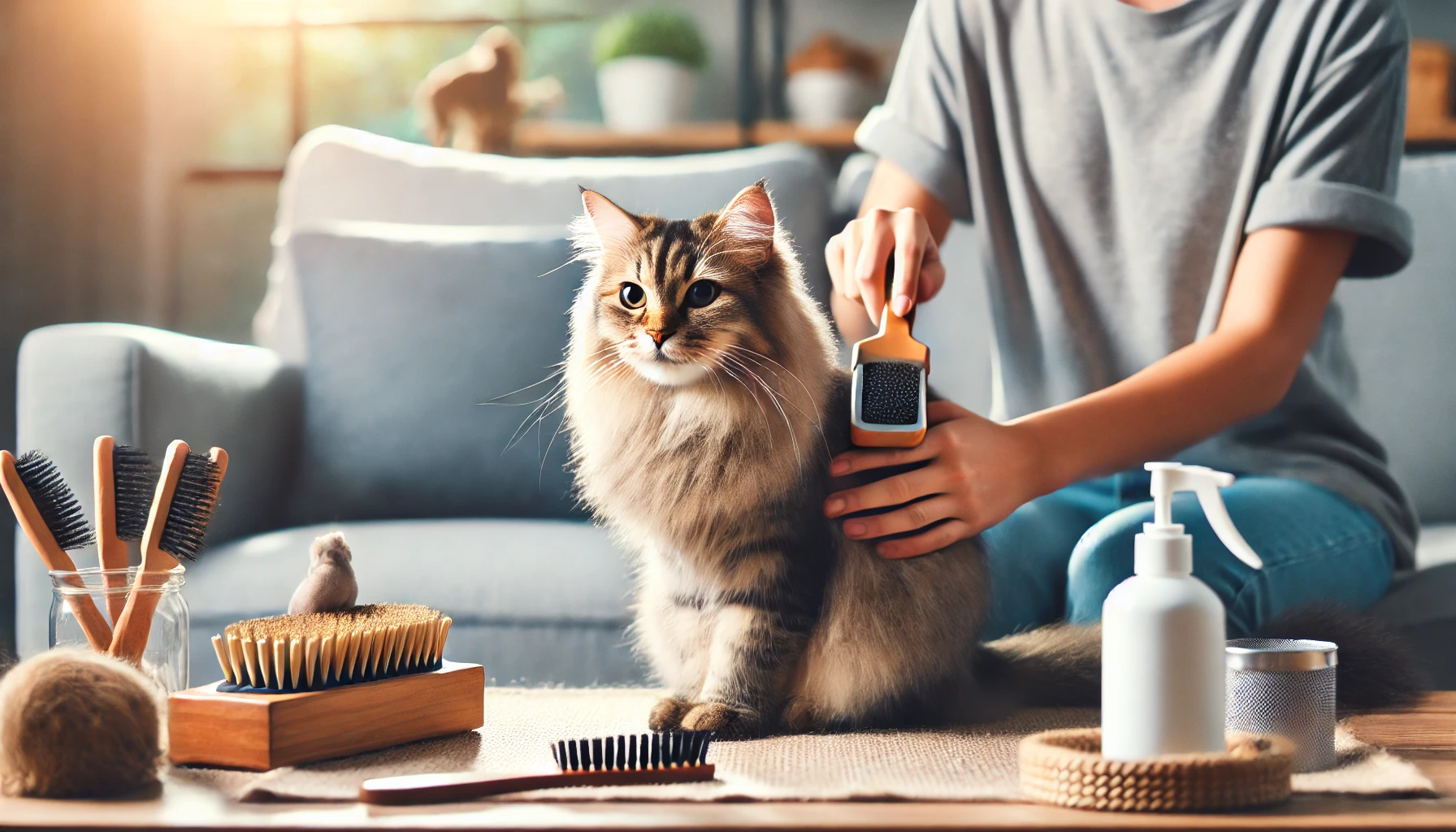
Grooming Regularly
Brush your cat several times a week using appropriate grooming tools to remove loose fur and prevent mats and tangles.
Regular grooming stimulates your cat’s skin, promotes blood flow, and distributes natural oils throughout the coat, helping to maintain a healthy and shiny coat.

Balanced Diet
A nutrient-rich, protein-based diet that includes essential fatty acids like omega-3 and omega-6 is crucial for maintaining optimal coat health and reducing cat shedding.
Hydration is also essential in keeping your cat’s skin and fur in the best condition possible.
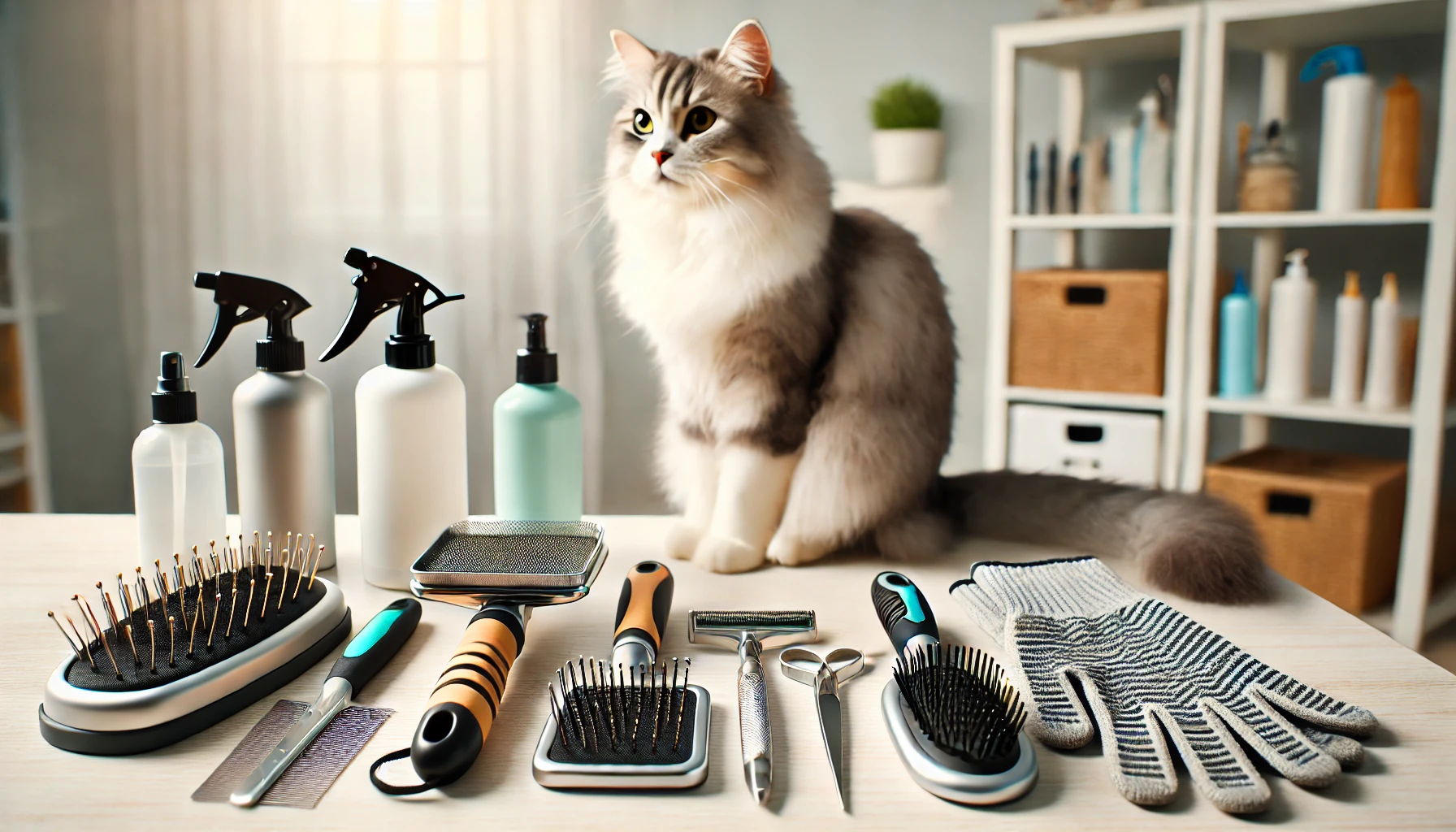
Right Tools
Invest in high-quality grooming tools such as slicker brushes, bristle brushes, de-shedding tools, and grooming gloves, based on your cat’s fur type.
These tools are invaluable in managing cat shedding effectively.
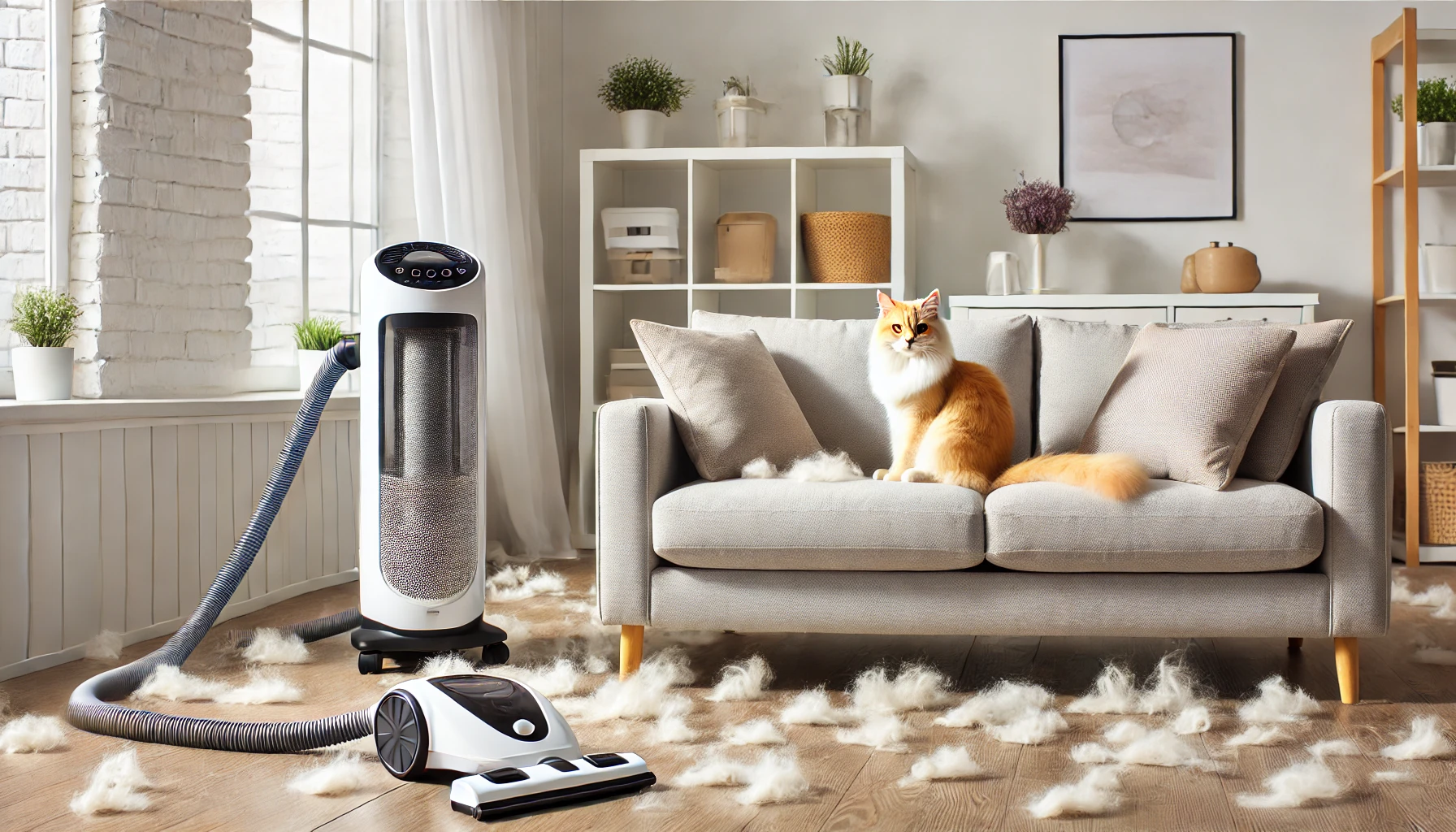
Environmental Control
Regular cleaning, such as vacuuming and using furniture covers, helps minimize the impact of cat fur around your home.
Maintaining a cool and comfortable environment can also reduce shedding.
Air purifiers with HEPA filters are useful in reducing fur and allergens from spreading.
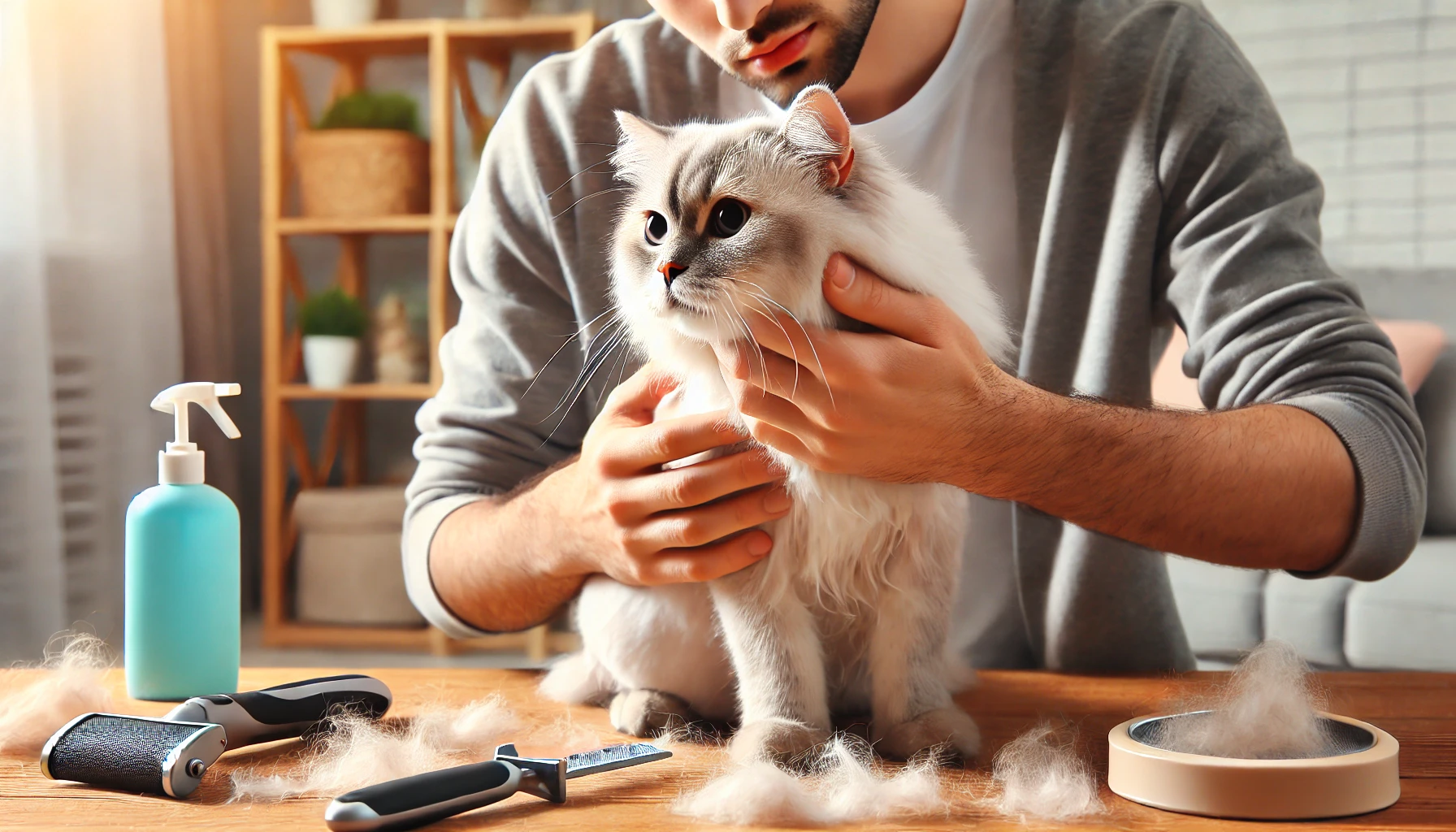
Shedding-Related Health Issues
It is important to monitor changes in your cat’s shedding patterns, as increased shedding may indicate underlying health problems.
Skin conditions such as dermatitis, allergies, or parasitic infections can lead to excessive hair loss.
If you notice bald patches, flaky skin, or excessive scratching, it’s essential to take your cat to a veterinarian for early diagnosis and treatment, preventing further complications and maintaining your cat’s health.
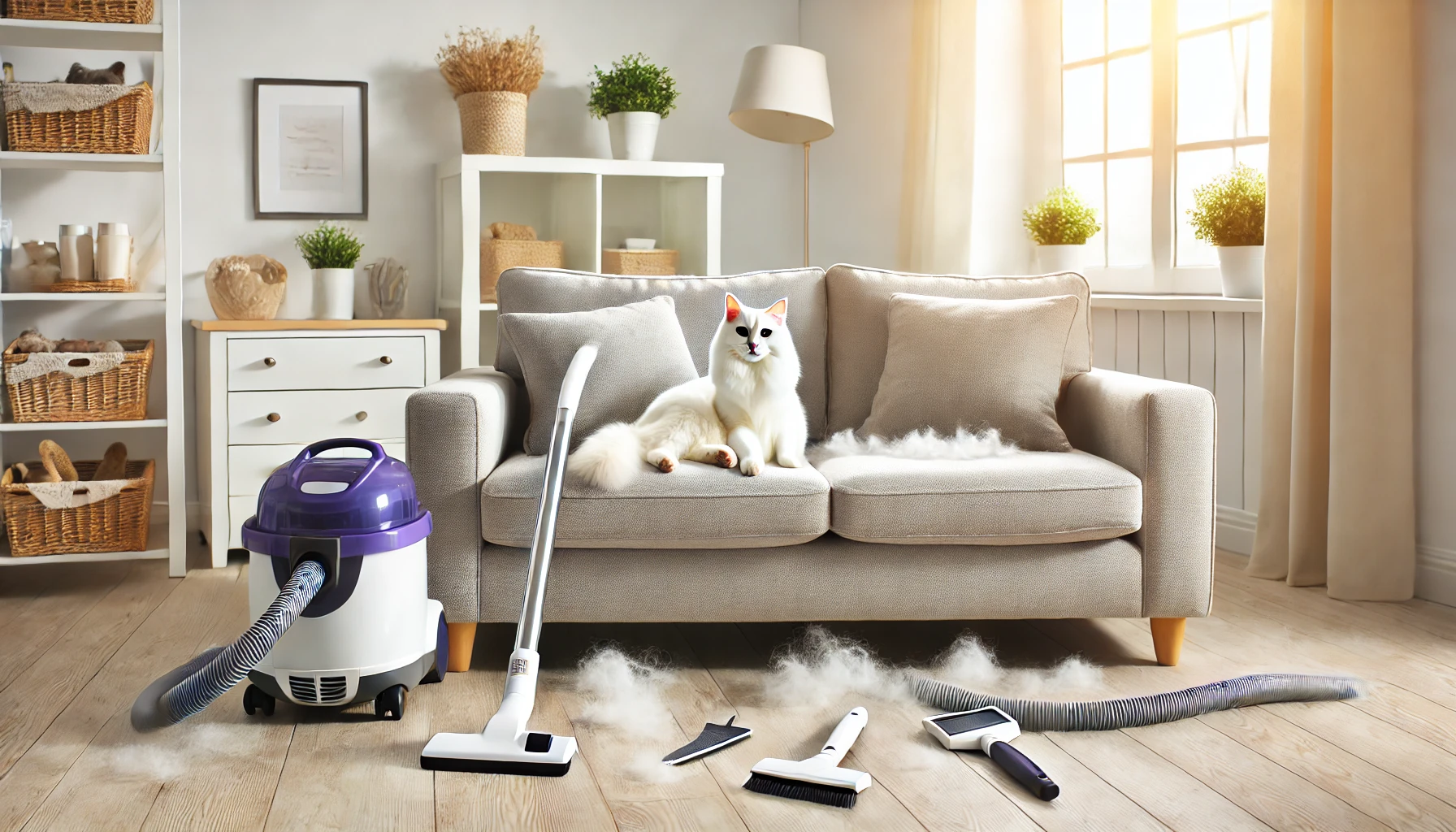
Managing a Comfortable Living Environment
By following these tips, you can create a cleaner and more comfortable living environment for both you and your cat.
Regular cleaning, proper grooming, and keeping your cat healthy are crucial components in managing cat shedding effectively.
While shedding is a natural process, proper care can significantly minimize its impact, helping you keep your home fur-free.
In conclusion, managing cat shedding requires consistency, the right tools, and a proactive approach to your cat’s health.
By incorporating these strategies into your daily routine, you can keep shedding under control, ensure your cat’s coat remains healthy, and maintain a clean and comfortable living space.
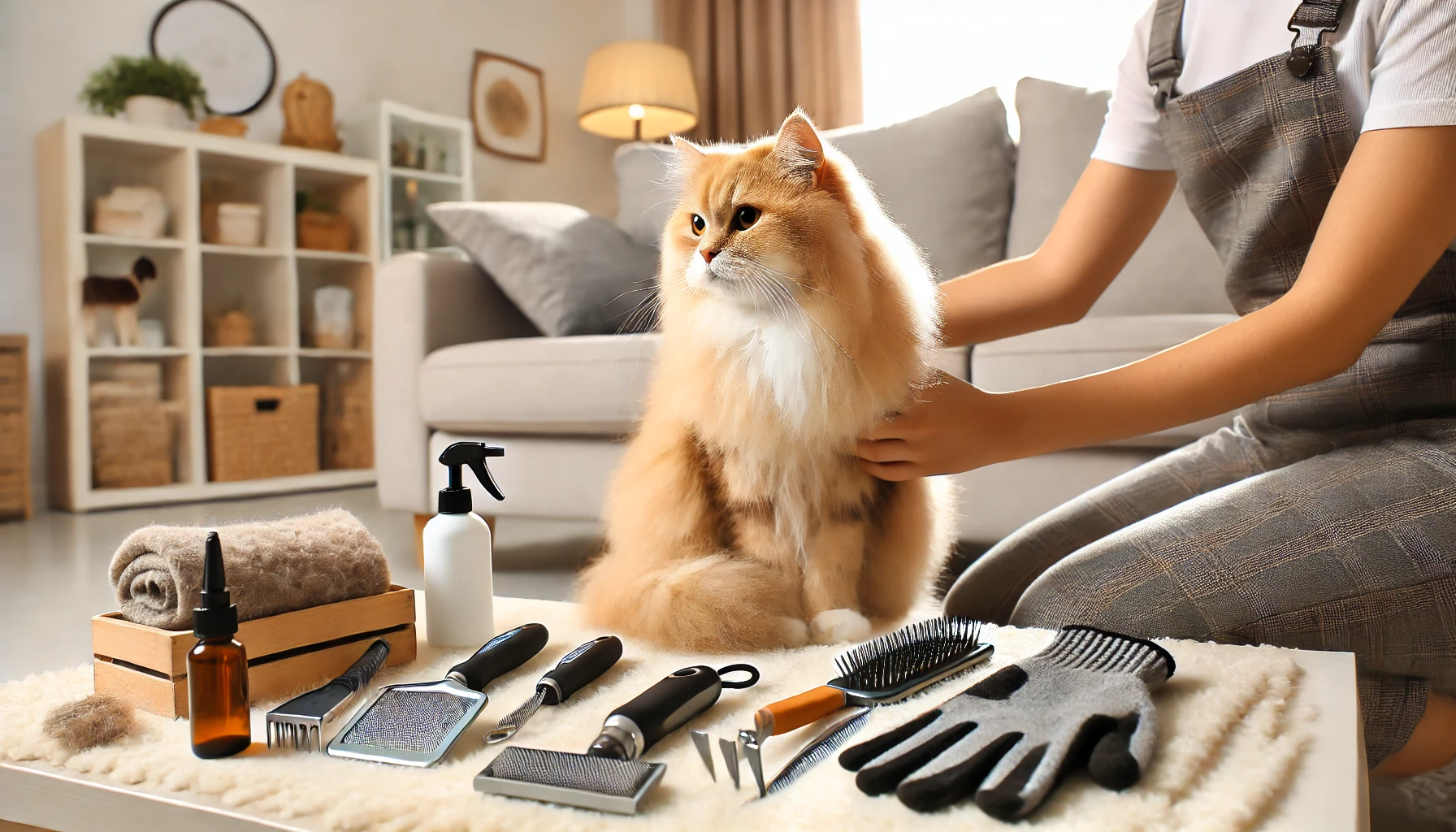
Managing Cat Shedding: Ten Frequently Asked Questions
Cat shedding can be a challenge for many pet owners.
Below are some of the most frequently asked questions about managing cat shedding, along with brief answers to help you better understand how to control and minimize shedding.
How often should I groom my cat to reduce shedding?
Groom your cat at least two to three times a week, depending on their fur type, using appropriate tools.
Regular grooming helps remove loose fur and can prevent mats and tangles, effectively reducing shedding.
What kind of diet helps reduce cat shedding?
A diet rich in high-quality protein and essential fatty acids, such as omega-3 and omega-6, improves coat conditions and lessens shedding.
Ensure your cat is well-hydrated to maintain healthy skin and reduce shedding.
Can dehydration in cats cause excessive shedding?
Yes, dehydration can lead to dry skin, which encourages excessive shedding.
Always make sure your cat has access to fresh water, and consider adding wet food to their diet to improve hydration levels.
Are certain breeds more prone to shedding?
Long-haired breeds like Persians and Maine Coons are more prone to shedding due to their thicker coats.
However, even short-haired cats can shed a significant amount, especially during seasonal changes or if health issues arise.
What tools are best for grooming a shedding cat?
Slicker brushes, bristle brushes, de-shedding tools, and grooming gloves are ideal for managing cat shedding.
Select tools that are appropriate for your cat’s specific fur type to achieve the best grooming results.
Do air purifiers help with cat shedding?
Yes, air purifiers with HEPA filters can help reduce the amount of loose fur and dander circulating in your home.
This is particularly helpful for people with allergies or sensitivities to pet fur and dander.
How do I decrease fur on furniture?
Use washable furniture covers, vacuum regularly, and choose fur-resistant fabrics like leather or tightly woven materials.
Anti-static sprays can also help repel fur, making it easier to clean your furniture.

